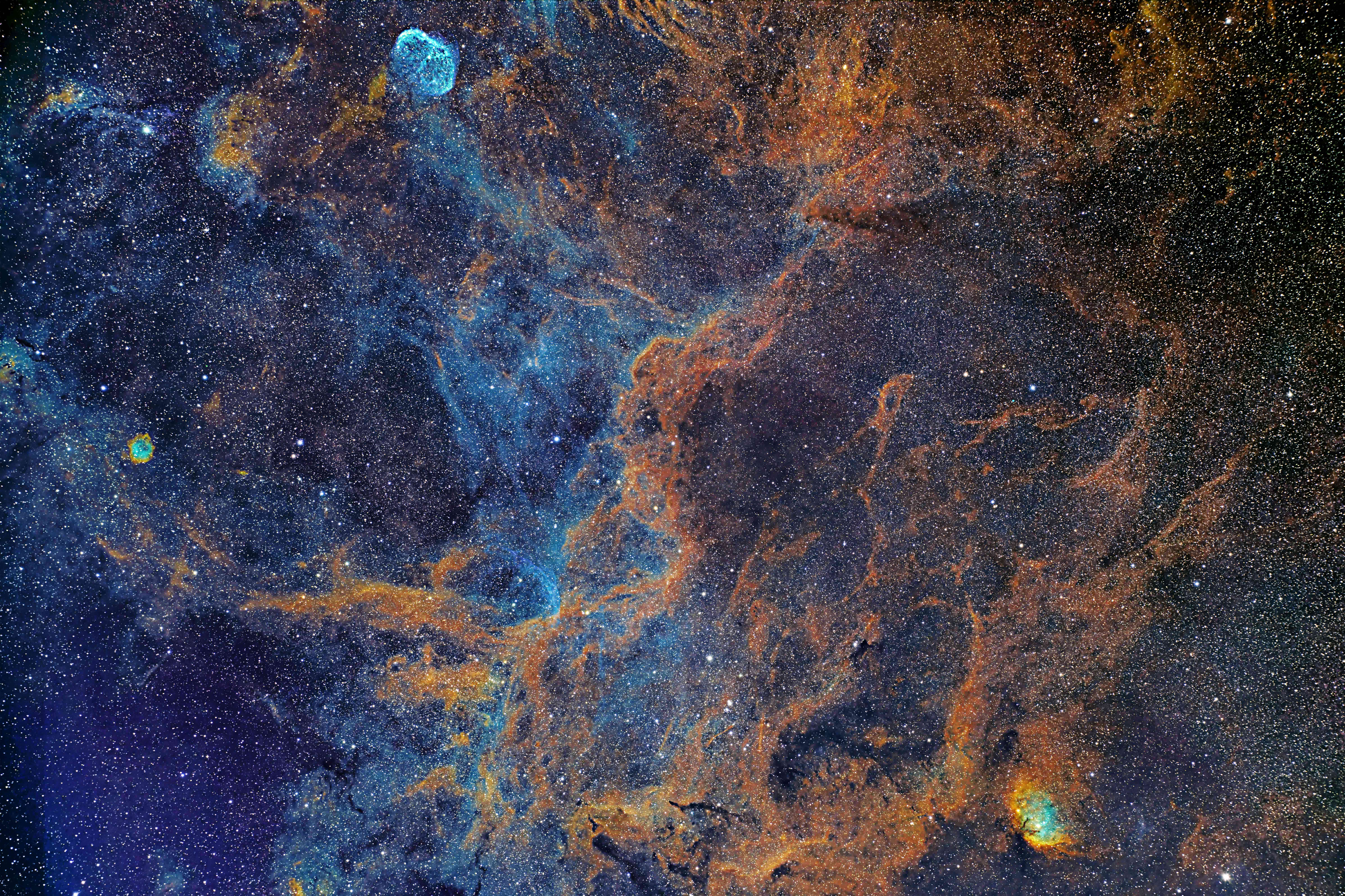| NGC 2359 -
Thor's Helmet Thor's Helmet is an emission nebula located in Canis Major. It lies 12,000 light years away from us and its central star is a Wolf-Rayet star which is thought to be in a pre-supernova stage of evolution. This image is my first experience with using a remote rental telescope. https://app.telescope.live has a number of telescopes located around the world that you can sign up to use for imaging sessions (for a fee of course). The rates are pretty reasonable for the quality of the images. This object was imaged from an observatory in Chile. For an image that is only a total of 30 min long, I think it turned out great. It was a lot of fun to process an image that came to me as high quality raw data. Image processed by Ron Yelton, original data from Telescope Live |
NGC 2070 -
Tarantula Nebula In our local group of galaxies, the Tarantula Nebula is the largest star forming regions as well as the largest Hydrogen II regions. It is so bright that if it were as close to us as the Orion Nebula (1600 Ly), it would produce visible shadows in in daylight. it is 160,000 light years away and is 931 light years in size. Processing this image was a bit difficult. The core region is extremely bright while the outer regions are much dimmer. To partially solve the exposure problem I used 10-minute exposures for the outer region and 5-minute exposures for the core. Image processed by Ron Yelton, original data from Telescope Live |
NGC
2170 - The Angel Nebula Image
processed by Ron Yelton, original data from
Telescope Live
There
is a lot going on in this nebula. It was discovered in
1784 by William Herschel. Parts of the nebula include
emission, |
|
Location: El Sauce
Observatory, Chile Date: December 16, 2019 Mount: Mathis MI-1000 Telescope: Planewave CDK24 f/6.6 (CHI-1) Camera: FLI PL9000 @ -25c Exposure: 3 x 10 min each for LRGBHa. Total: 30min. |
Location: El sauce Observatory, Chile Date: March 22, 2020 Mount: Mathis MI-1000 Telescope: Planewave CDK24 f/6.6 (CHI-1) Camera: FLI PL9000 @ -25c Exposure: 9 x 10 min LRGB. Total 90 min. |
Location:
El Sauce Observatory, Chile Date: March 6, 2021 Mount: Mathis MI-1000/1250 Telescope: Planewave CDK24 (CHI-1) Camera: FLI ProLine PL 9000 @ -25c Exposure: 6 x 10 min each for Ha and OIII. Total: 1 hr. |
 |
 |
 |
| Sharpless 2-136
(Sh2-136) The Ghost of Cepheus The Ghost of Cepheus is a reflection nebula located in Cepheus on the edge of the Cepheus Flare molecular cloud complex. There are several new stars embedded in the nebula itself which give it a brownish color. It is usually referred to as a Globule. This nebula spans about 2 light years across and lies about 1470 light years away. The star right in the middle of the nebula is a proto-star. Image processed by Ron Yelton, original data from Telescope Live |
SpaceX Starlink
Satellite Effects on Astrophotography This was my first encounter with the Starlink satellites. This is a 10 minute image from a group of six through a red filter that are part of the image to the left. Software developers are going to have to come up with some very powerful programs that can handle these issues. Using CCDStack, it took almost three hours to get this streak processed out enough to be able to use the image. If the streak is so bright that it saturates the pixels in the camera, then all of the data underneath the streak is lost. That's the problem for both amateur and professional imagers and astronomers. Image processed by Ron Yelton, original data from Telescope Live |
NGC 2239
(Caldwell 49) - The Rosette Nebula The Rosette Nebula is a HII region in Monoceros and lies about 5200 light-years away. It is 65 light-years in diameter which is about half the diameter of our own Milky Way galaxy. The stars in the center are an open cluster (NGC) 2237) which is made up of 36 new stars. If you zoom deep into this image and scroll through it you'll find at least an additional 45 galaxies. This image is different in that the colors are not what we usually see in an image. This object, the Rosette Nebula is very difficult to see in our normal visible light, but taken through different filters, in this case - Hydrogen, Oxygen and Sulphur, we can bring out details of an object that might not normally be visible. Image processed by Ron Yelton, original data from Telescope Live |
|
Location:
IC Astronomy Observatory,
Spain
Date: July 17, 2020Mount: Officina Stellare EQ Mount Telescope: Officina Stellare Pro RC 700 (27" f/8) (SPA-2) Camera: FLI PL16803 23' x 23' @-25c Exposure: LRGB 6 x 10 min each Total: 1 hr |
IC Astronomy Observatory,
Spain
Date: July 17, 2020 Mount: Officina Stellare EQ Mount Telescope: Officina Stellare Pro RC 700 (27" f/8) (SPA-2) Camera: FLI PL16803 23' x 23' @-25c Exposure: LRGB 6 x 10 min each Total: 1 hr. |
Location: IC
Astronomy Observatory, Spain
Date: February 20, 2021Mount: ASA DDM85 Telescope: ASA 500N (CHI-2) Camera: FLI PL16803 @-30c Exposure: SHO 6 x 10 min each Total: 1 hr. |
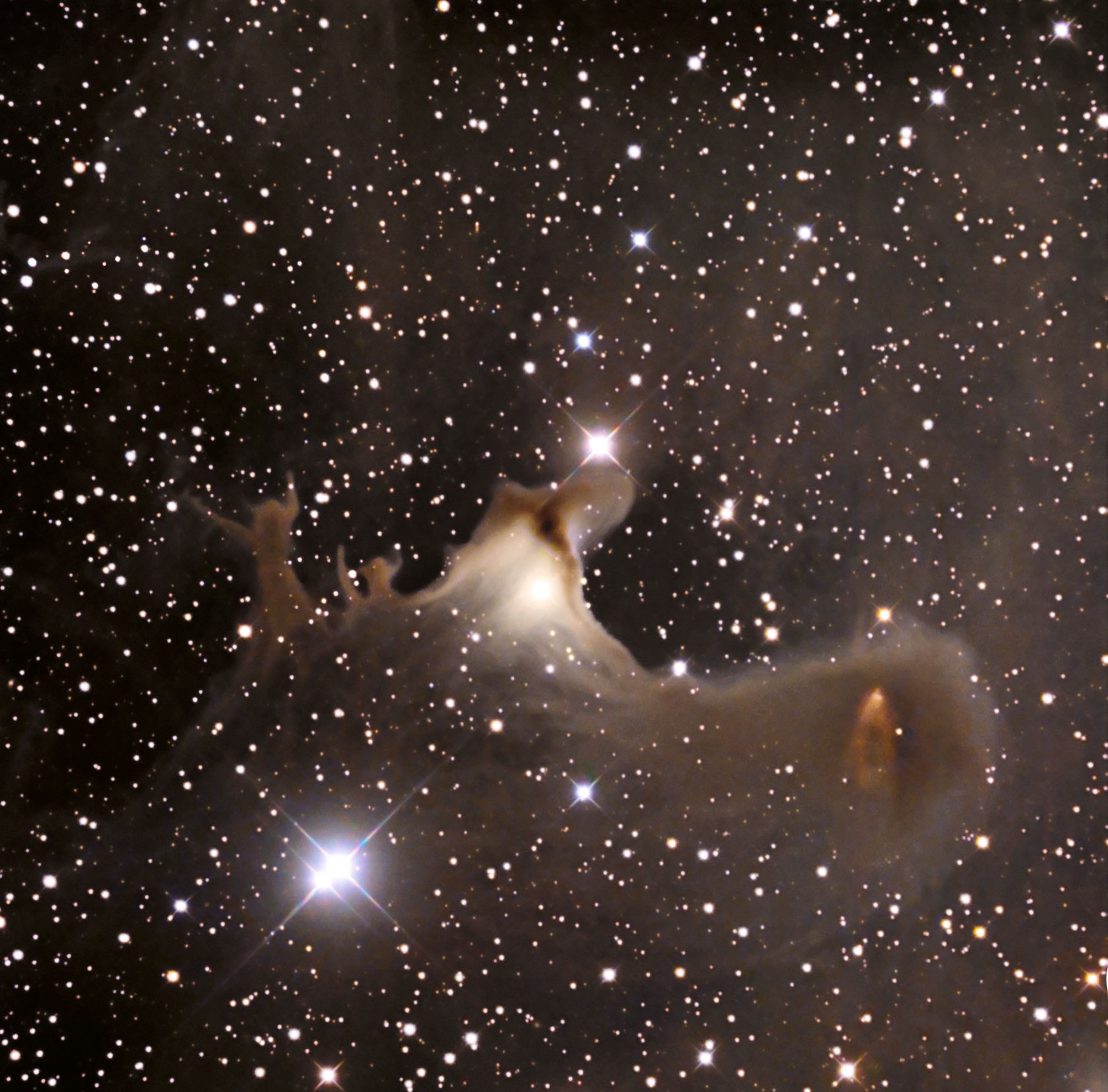 |
 |
 |
| IC 443
(Sh2-248) Jellyfish Nebula IC 443 also known as the Jellyfish Nebula and Sh3-248 is a galactic supernova remnant (SNR) in the constellation Gemini. It is located near the star Eta Geminorum. Its distance is roughly 5,000 light years from Earth. IC 443 may be the remains of a supernova that occurred 3,000 - 30,000 years ago. The same supernova event likely created its neutron star, the collapsed remnant of the stellar core. IC 443 is one of the best studied cases of supernova remnants interacting with its surrounding molecular clouds. Another fun image taken with the wonder Telescope Live remotely operated telescopes in Chile. This particular telescope - the Planewave 24" and the Finger Lakes Instruments FLI PL 9000. This first image is the basic LRGB. Image processed by Ron Yelton, original data from Telescope Live |
IC 443 (Sh2-248) Jellyfish Nebula This second image in the Sh2-248 series was taken through just a Hydrogen Alpha filter, commonly referred as Narrow Band imaging. Sometimes with the color images it's really easy to loose the details in the color. This image in Ha looks nice because Black and White gives a much better feel for the details in the many filaments of hydrogen gas. Image processed by Ron Yelton, original data from Telescope Live |
IC 443 (Sh2-248) Jellyfish Nebula This third version of IC 443 is a combination of the LRGB and Hydrogen Alpha (LRGB+Ha). In versions that other folks have done this version might be much more red. I admit that I'm still really new to Narrow Band (NB) processing, so I'm not quite as aggressive as others with more experience will be. However, by keeping the red slightly muted I feel that I can keep more of the details. Image processed by Ron Yelton, original data from Telescope Live |
|
Location:
El Sauce Observatory, Chile Date: October 25, 2020 Mount: Mathis MI-1000 Telescope: Planewave CDK24 f/6.6 (CHI-1) Camera: FLI PL9000 @ -25c Exposure: 8 x 10 min each for LRGBHa. Total: 1 hr 20 min. |
Location: El Sauce
Observatory, Chile Date: October 25, 2020 Mount: Mathis MI-1000 Telescope: Planewave CDK24 f/6.6 (CHI-1) Camera: FLI PL9000 @ -25c Exposure: 8 x 10 min each for LRGBHa. Total: 1 hr 20 min. |
Location: El sauce
Observatory, Chile Date: October 25, 2020 Mount: Mathis MI-1000 Telescope: Planewave CDK24 f/6.6 (CHI-1) Camera: FLI PL9000 @ -25c Exposure: 8 x 10 min each for LRGBHa. Total: 1 hr 20 min. |
 |
 |
 |
| Gum 16 There are two schools of thought as to what this area actually is. One is that it is a still expanding supernova remnant from about 1 million years ago. The other is that it is an evolved HII region. Either way, the consensus is that it is an emission nebula. It lies about 1470 light-years away. These three images are my first attempt at narrowband processing. Instead of taking the images in the visual light band, these are taken through Hydrogen Alpha and Oxygen III filters. The Ha or OIII filters were assigned to the RGB channels in various combinations to get the different outcomes. This first one was combined in OHH. Image processed by Ron Yelton, original data from Telescope Live |
Gum 16 This second image in this Gum 16 series was combined as HOO. I think that this one is my favorite of the three. Somewhere in this huge complex is the Vela Supernova Remnant. This region named after its discoverer, the Australian astronomer Colin Stanley Gum (1924–1960). Image processed by Ron Yelton, original data from Telescope Live |
Gum 16 This third image was combined in OOH. This area of Hydrogen and Oxygen gas contain about 32 cometary globules.these are areas of gas of varying densities. The radiation pressures from nearby stars erodes the gas leaving globules that resemble comets. Along with ordinary Bok globules they are associated with star formation. Image processed by Ron Yelton, original data from Telescope Live |
|
Location:
Heaven's Mirror Observatory, Australia Date: January 11, 2021 Mount: Paramount MX+ Telescope: FSQ-106ED (AUS-2) Camera: FLI PL16083 @ -25c Exposure: 8 x 10 min each for Ha and OIII. Total: 1 hr 20 min. |
Location: Heaven's Mirror
Observatory, Australia
Date: January 11, 2021 Mount: Paramount MX+ Telescope: FSQ-106ED (AUS-2) Camera: FLI PL16083 @ -25c Exposure: 8 x 10 min each for Ha and OIII. Total: 1 hr 20 min. |
Location: Heaven's Mirror
Observatory, Australia Date: January 11, 2021 Mount: Paramount MX+ Telescope: FSQ-106ED (AUS-2) Camera: FLI PL16083 @ -25c Exposure: 8 x 10 min each for Ha and OIII. Total: 1 hr 20 min. |
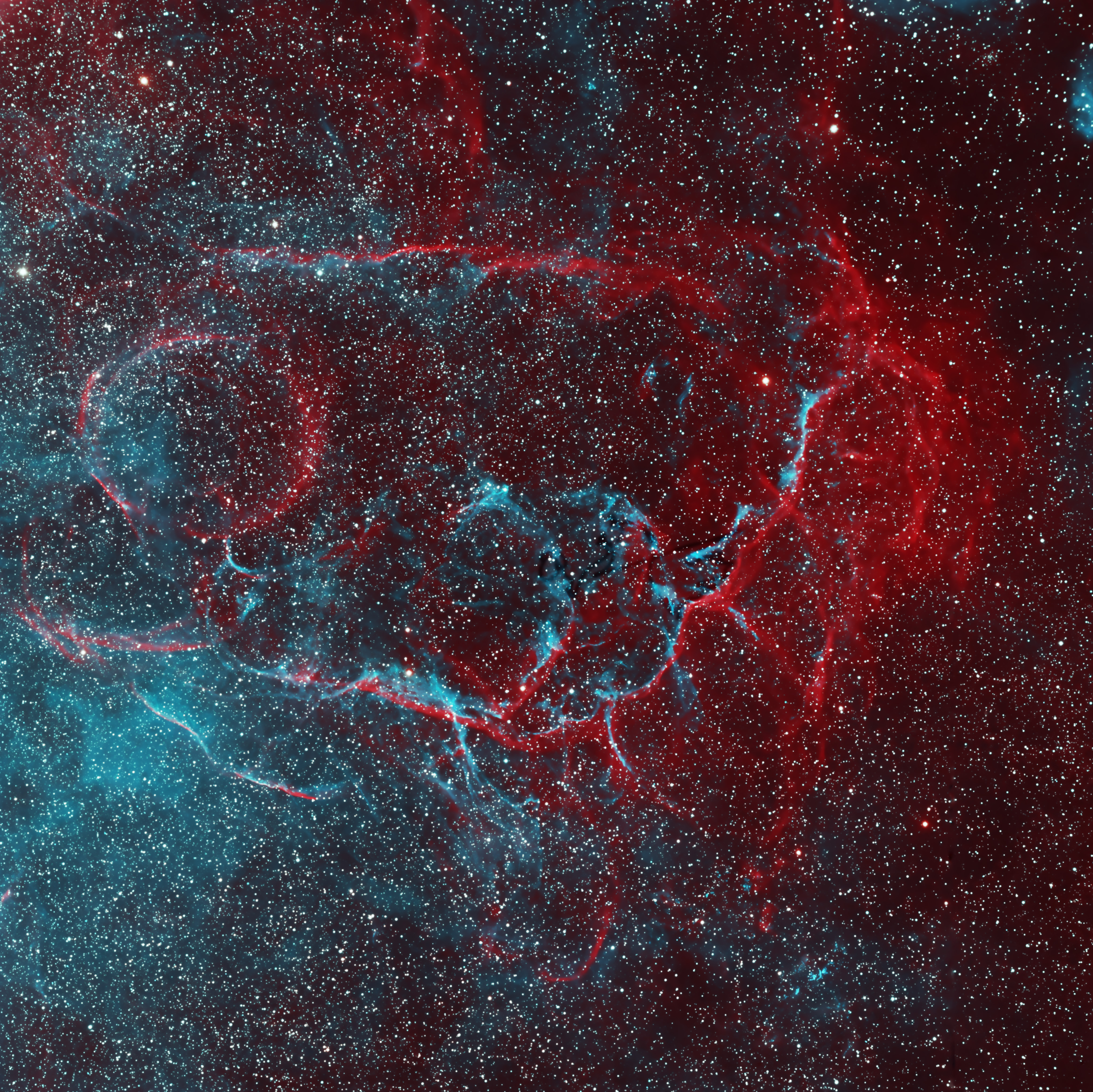 |
 |
 |
| Sh2-308 -
The Dolphin Nebula This nebula is a Hydrogen II region. It was first formed about 70,000 years ago from the Wolf-Rayet star EZ Canis Majoris in the center. These gases are traveling outward at around 3.8 million mph as a result of the star throwing off its outer hydrogen layers in pre-supernova fits. Eventually this star will explode as a supernova and wipe out the nebula. Distance from earth is estimated at between 1800 to 6000 light-years from Earth. Its diameter is around 60 light-years. This image was taken through an Oxygen III filter. Image processed by Ron Yelton, original data from Telescope Live |
Sh2-308 -
The Dolphin Nebula This version of the Dolphin Nebula is a combination of Oxygen III and Hydrogen Alpha filters. Image processed by Ron Yelton, original data from Telescope Live |
Sh2-308 -
The Dolphin Nebula Here is another version of the Dolphin nebula. The interesting thing about processing an astro image is that it's very difficult to replicate how you did it the first time. This one has a bit more blue than cyan, and the red Ha regions have been accentuated a bit more. Image processed by Ron Yelton, original data from Telescope Live |
|
Location: El Sauce
Observatory, Chile Date: December 17, 2020 Mount: ASA DDM85 Telescope: ASA 500N (CHI-2) Camera: FLI PL16803 @ -25c Exposure: 6 x 10 min Ha. Total: 1 hr. |
Location:
El Sauce Observatory, Chile Date: December 17, 2020 Mount: ASA DDM85 Telescope: ASA 500N (CHI-2) Camera: FLI PL16803 @ -25c Exposure: 6 x 10 min each for Ha and OIII. Total: 1 hr. |
Location: El
Sauce Observatory, Chile Date: December 17, 2020 Mount: ASA DDM85 Telescope: ASA 500N (CHI-2) Camera: FLI PL16803 @ -25c Exposure: 6 x 10 min each for Ha and OIII. Total: 1 hr. |
 |
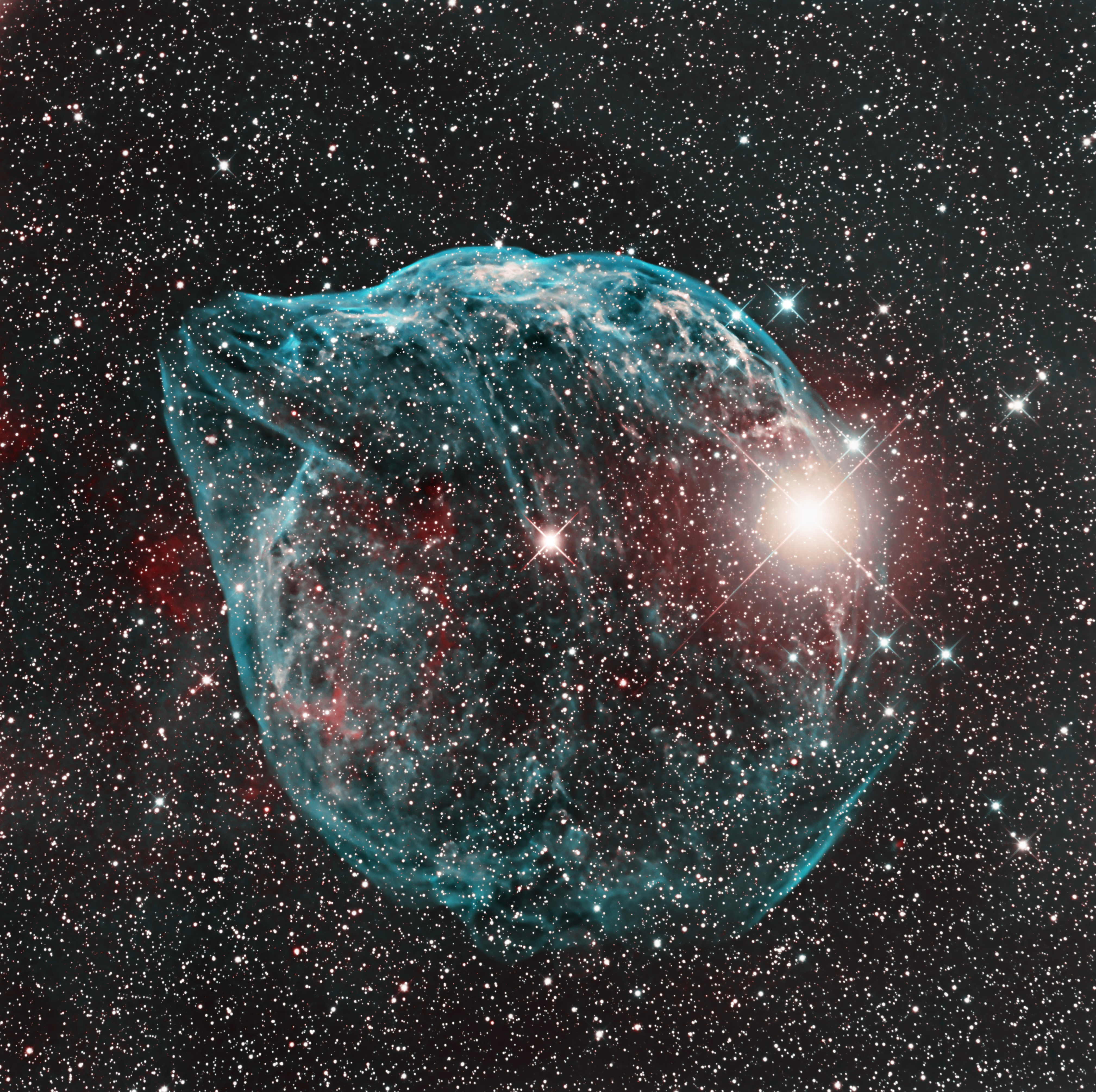 |
 |
| Messier 1 -
The Crab Nebula (WB) The Crab Nebula (Messier 1) is a supernova remnant in the constellation Taurus. At its heart is a neutron star that is also a pulsar that is almost 20 miles in diameter and spins at a rate of 30.2 rotations per second. It corresponds with a bright supernova recorded by Chinese astronomers in 1054. This nebula was the first object identified that corresponds with a historical supernova explosion.Scientists are still trying to figure out why this SN remnant has such an unusually irregular shape. Usually, SN remnants have a much more symmetrical, spherical shape. this version of the image is in the visible RGB spectrum. Image processed by Ron Yelton, original data from Telescope Live |
Messier 1 -
The Crab Nebula (HSO) This version of the Crab Nebula is a narrowband image taken through Hydrogen Alpha, Oxygen III and Sulphur II filters. I tried different combinations of assigning the filters to the RGB channels and this one seemed to turn out the best. Red = Ha, Green = Sulphur II, Blue = Oxygen III. Image processed by Ron Yelton, original data from Telescope Live |
NGC 3372 -
The Carina Nebula (SHO) The Carina Nebula was discovered by Nicolas-Louis de Lacaille in 1752 from the Cape of Good Hope. It's four times the size and even brighter than the Great Orion Nebula. It lies about 8,500 light-years from Earth and includes both bright and dark areas of nebulosity as well as numerous other objects. This image was taken with a wide field camera. Sulphur II = Red, Hydrogen Alpha = Green, Oxygen III = Blue Image processed by Ron Yelton, original data from Telescope Live |
|
Location:
El Sauce Observatory, Chile Date: January 9, 2021 Mount: ASA Alt-Az Direct Drive Telescope: 1000 (39" RC) (CHI-3) Camera: FLI PL16803 @ -25c Exposure: 8 x 10 min LRGB. Total: 1 hr 20 min |
Location:
El Sauce Observatory, Chile Date: January 9, 2021 Mount: ASA Alt-Az Direct Drive Telescope: 1000 (39" RC) (CHI-3) Camera: FLI PL16803 @ -25c Exposure: 8 x 10 min each for Ha and OIII. Total: 1 hr 20 min |
Location: IC
Astronomy Observatory, Spain Date: May 11, 2021 Mount: Astro-Physics 1600 Telescope: Officina Stellare RH 200 (CHI-6) Camera: FLI ML16200 @ -20 Exposure: 5 x 10 min each for SII, Ha and OIII. Total: 50 min |
 |
 |
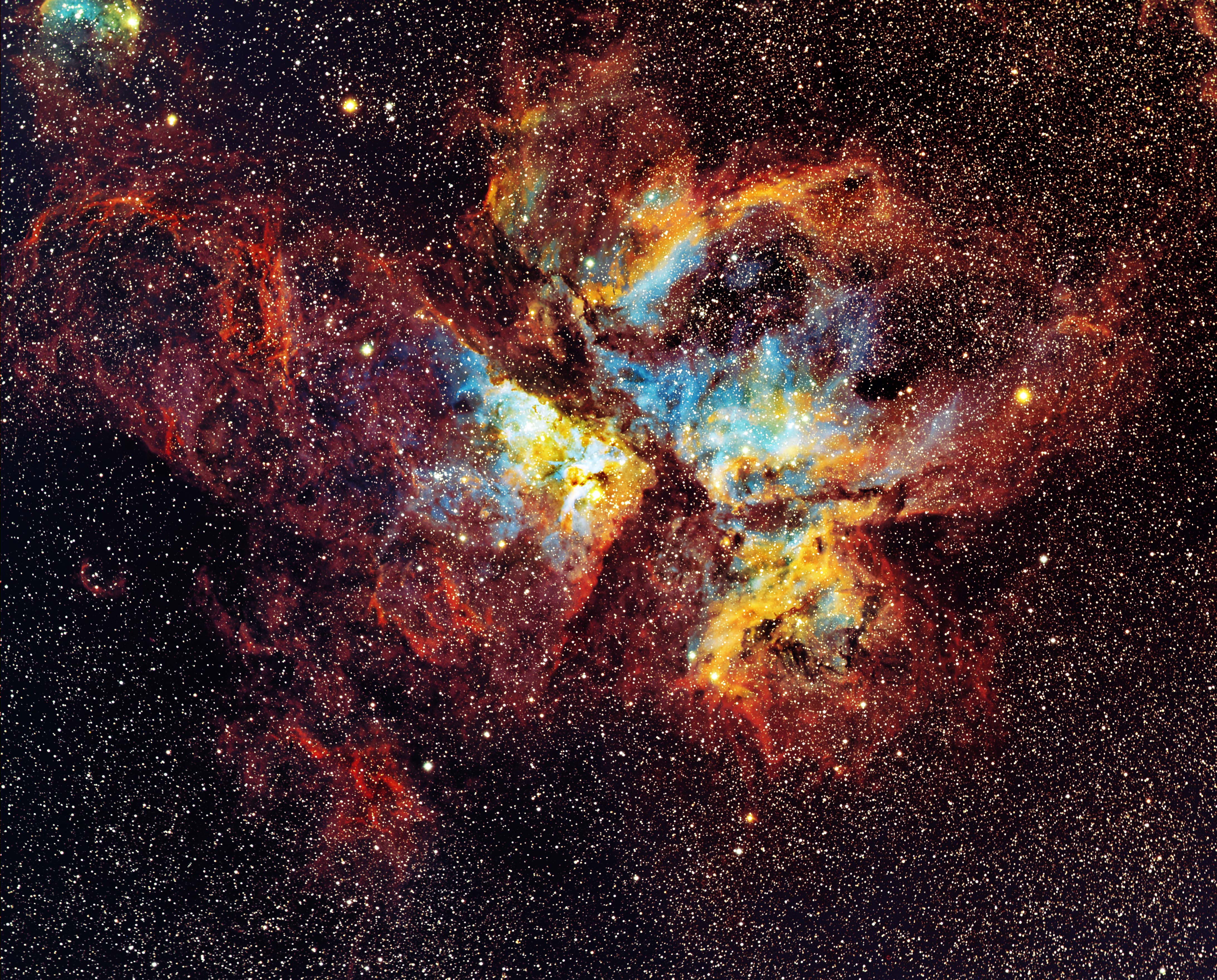 |
| NGC 7000 -
The North America Nebula
This
nebula was discovered by William Herschel in 1786.
It was cataloged again and photographed by Max Wolf,
a pioneer in astrophotography in 1860. He noticed
that the nebula resembled the shape of North
America. Covering a huge amount of sky, it is about
140 light-years across, 90 light-years north to
south and about 2500 light-years distant. |
NGC 7000
- The North America Nebula This version was processed in a different way from the previous image. In this one OIII is assigned to the Red Channel, Ha to the Green channel and SII to the Blue Channel (OHS). Image processed by Ron Yelton, original data from Telescope Live |
NGC 7000 - The
North America Nebula
This version is what the North America Nebula looks like when taken through just the Hydrogen Alpha filter. Image processed by Ron Yelton, original data from Telescope Live |
|
Location: IC Astronomy
Observatory, Spain Date: October 29, 2020 Mount: Paramount MX+ Telescope: FSQ-106EDX4 (SPA-3) Camera: FLI PL16083 Exposure: 6 x 10 min each for Ha, OIII and SII. Total: 1 hr |
Location: IC Astronomy
Observatory, Spain Date: October 29, 2020 Mount: Paramount MX+ Telescope: FSQ-106EDX4 (SPA-3) Camera: FLI PL16083 Exposure: 6 x 10 min each for Ha, OIII and SII. Total: 1 hr |
Location: IC Astronomy
Observatory, Spain Date: October 29, 2020 Mount: Paramount MX+ Telescope: FSQ-106EDX4 (SPA-3) Camera: FLI PL16083 Exposure: 6 x 10 min Ha. Total: 1 hr |
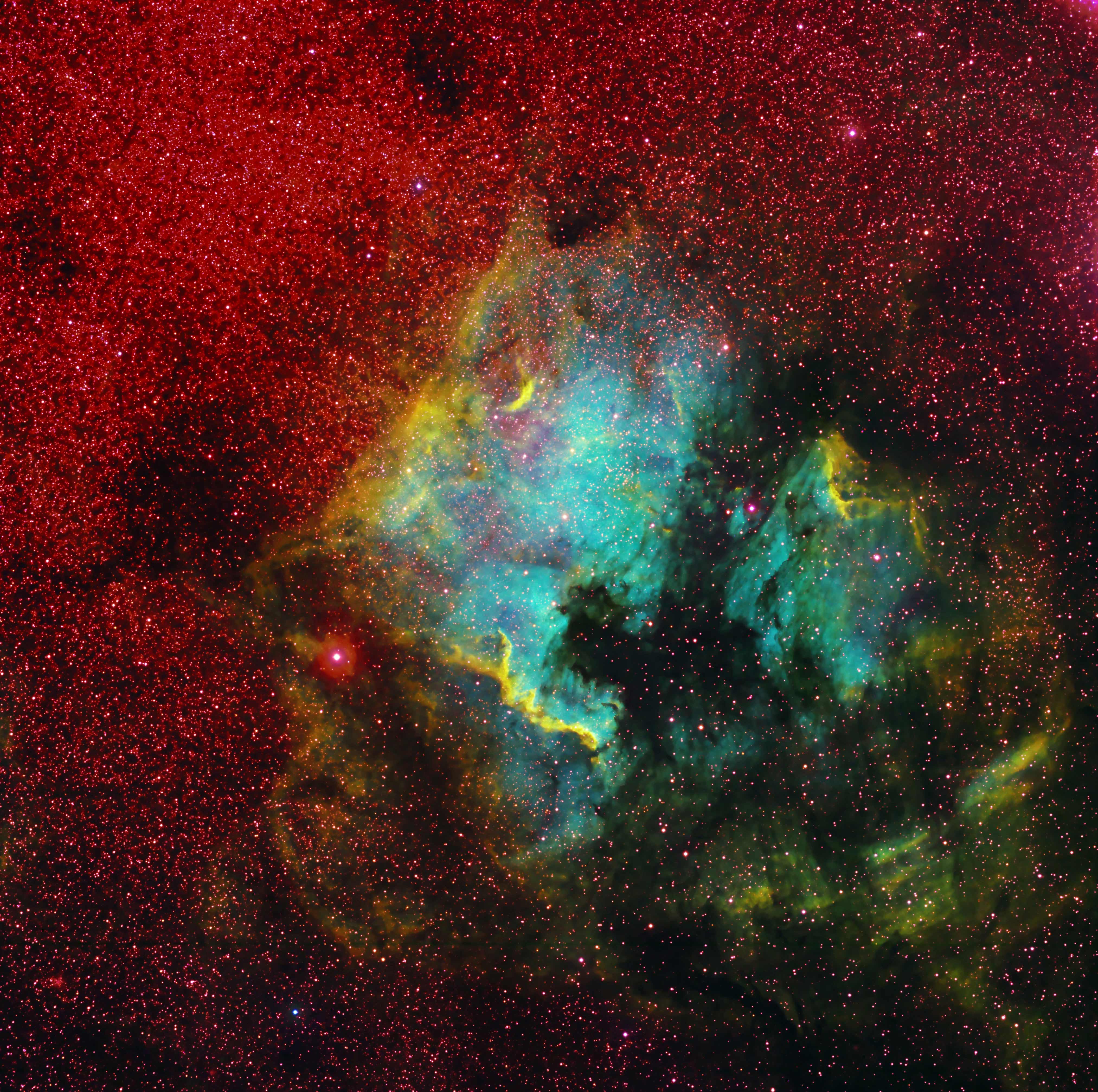 |
 |
 |
| NGC 6188 -
The Dragons of Ara
Nebula (SHO) The Dragons of Ara is just a small part of a much larger molecular cloud. This part of the nebula is an emission nebula that includes some dark nebula as well. It lies about 4000 light-years away from us and is about 300 light-years in diameter. Image processed by Ron Yelton, original data from Telescope Live |
IC 2944 -
The Running Chicken
Nebula (SHO) The Running Chicken Nebula is an emission nebula located in the constellation Centaurus. It features a number of Bok nodules, although there is no evidence of star formation in any of them. This image is a wider field view of the nebula than the one to the right which is a more zoomed-in look at the same region. Image processed by Ron Yelton, original data from Telescope Live |
IC 2944
- The Running
Chicken Nebula
(SHO) This image is a more zoomed-in look at the same nebula. Both images used Sulphur, Hydrogen and Oxygen filters instead of the traditional Red, Green and Blue. Image processed by Ron Yelton, original data from Telescope Live |
|
Location: IC Astronomy
Observatory, Spain Date: July 7, 2021 Mount: OS EQ Telescope: Officina Stellare ProRC 700 (SPA-2) Camera: FLI PL16083 @ -25c Exposure: 6 x 10 min each for Ha, OIII, SII,and Lum Total: 1 hr |
Location: El Sauce
Observatory, Chile Date: July 12, 2021 Mount: ASA DDM85 Telescope: ASA 500N (CHI-6) Camera: FLI PL16803 @ -25c Exposure: 3 x 10 min for Ha, OIII, SII,and Lum Total: 30 min |
Location: El Sauce
Observatory, Chile Date: July 12, 2021 Mount: ASA DDM85 Telescope: ASA 500N (CHI-4) Camera: FLI PL16803 @ -25c Exposure: 7 x 10 min for Ha, OIII, and SII. Total: 1 hr 10 min |
 |
 |
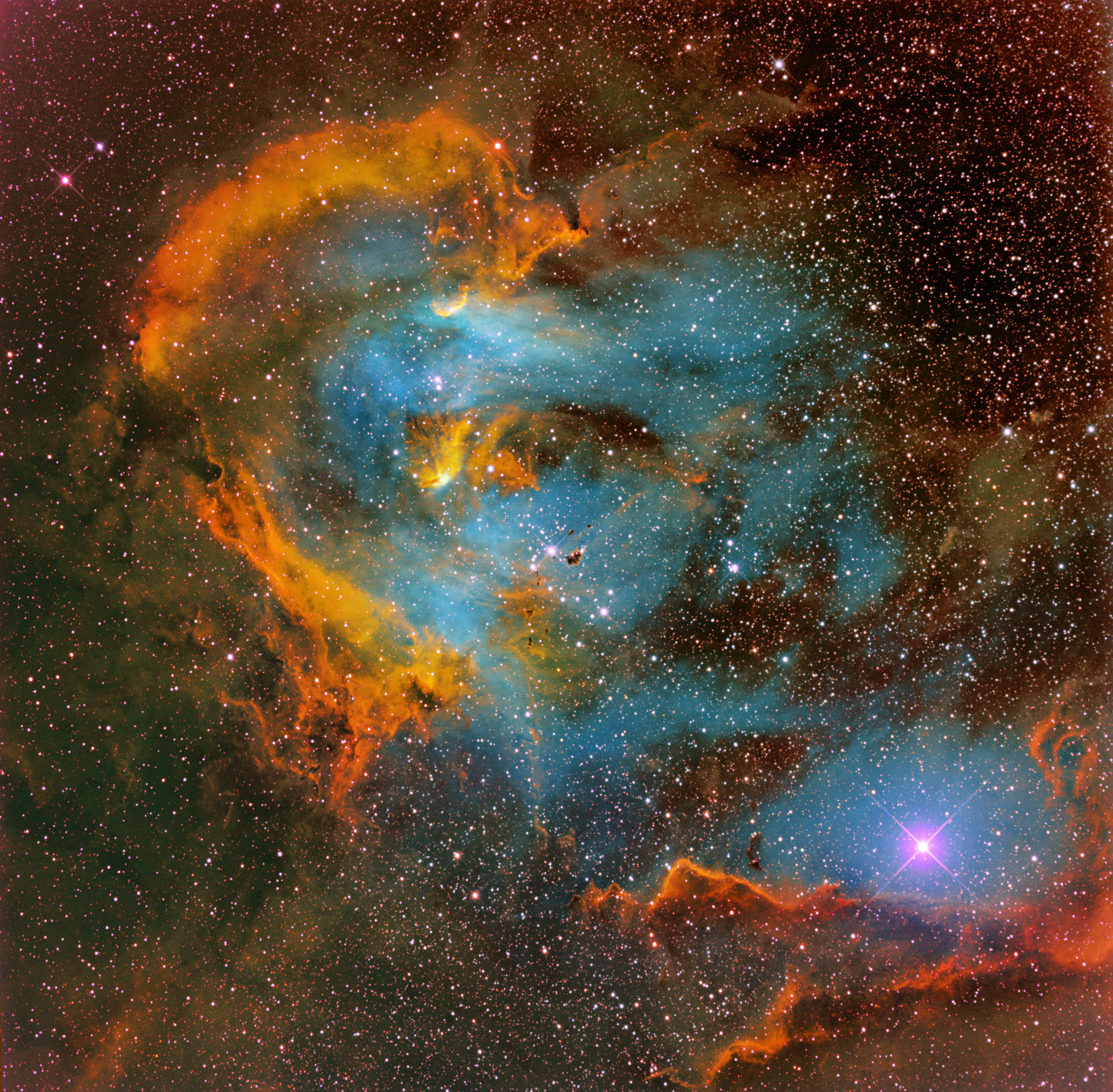 |
| NGC 2736 - The Pencil Nebula /
Herschel's Ray
Part of the Vela Supernova remnant it is thought to have been formed by the shockwave of the greater Vela Supernova. is lies about 815 LY away from us and is moving along at 400,000 MPH. Image processed by Ron Yelton, original data from Telescope Live |
Telescope Live Back in 2019, shortly after I signed up as a customer, I submitted my first image to their gallery - NGC 5128 (Centaurus A). Shortly after that, their director of Marketing sent me an e-mail asking if they could use that image in an advertisement in an english astronomy magazine. Of course I said yes. Her is a link to the article. I have been officially published - YAY! Astronomy Now Magazine Ad |
The Doodad
Nebula
This dark nebula is commonly known as the Doodad Nebula. It's a long, cold molecular cloud in the constellation Musca (The Fly). Right near the right end if the nebula is NGC 4372, a globular cluster. Processed with PixInsight. Image processed by Ron Yelton, original data from Telescope Live |
|
Location: IC Astronomy
Observatory, Spain Date: December 16, 2020 Mount: Mathis MI-1000 Telescope: Planewave CDK24 (CHI-1) Camera: FLI ProLine PL 9000 @ -25c Exposure: 6 x 10 min each for Ha + LRGB: 1 hr |
Telescope Live
When I attended the Advanced Imaging Conference in 2022, I stopped in at the vendors area to say hi to Marco at Telescope Live. I have been one of their earliest and active customers and they had a gift for me - a thank you card that was made from my posted image of the Rosette Nebula and a bottle of Italian Chianti (he lives in Italy). Mentore asked if i would say a few words about T.L. for their website blog. Here it is. Ron's Telescope Live Interview |
Location:
Heaven's Mirror Observatory,
Australia
Date: April - May 2022 Mount: Paramount MX+ Telescope: FSQ-106ED (AUS-2) Camera: FLI PL16083 @ -25c Exposure: 15 x 10 min each for RGB. Total: 2hrs 30 min |
 |
|
 |
| Sh2-311 (NGC
2467) - Skull and
Crossbones Nebula This nebula is located in the constellation Puppis. Puppis being the poop deck of the ship Argo, sailed by Jason and the Argonauts of Greek mythology. If you tilt your head 45 degress to the left, it looks like the face of a mandril. It is a region of gasses that form a large star factory. Recent studies have detected at least 45 proto-stars (stars in the process of being formed). The region is dominated by a massive young star (the large blue one on the left side). Image processed by Ron Yelton. Original data from Telescope Live Observation Bundle |
Sh2-185 (Sharpless
2-185) This region of faint nebulosity is dominated by the star Gamma Cas, commonly referred to as Navi, in the constellation Cassiopeia, and is part of the greater Gamma Cas Nebula Complex. Just below the star is IC 63, a denser cloud of gas that looks like an arrowhead that is pointed at Navi. It is commonly referred to as The Ghost of Cassiopeia. I tried to image IC 63 a few years ago down in Borrego Springs, but its close proximity to Navi overwhelmed the sensitivity of the chip in my camera. This image was processed with both PixInsight and Photoshop. This Image was processed by Ron Yelton. The original data is from Telescope Live Observation Bundles |
Barnard 252 (B252) The Dolphin Nebula Barnard 252 is a region of cloud and gas and dust. Its density, and the fact that there are no nearby stars to make it a reflection or emission nebula make it what is called a Dark Nebula. this one is located in our southern constellation, Scorpius. this dark nebula is usually referred to as The Dolphin Nebula - not to be confused with a planetary nebula, Sh2-308, which goes by the same name. This image was taken using a very wide field telescope, which means that it is photographing a very large region of the sky. thus, all of the stars which give it a nice glow. My processing software, PixInsight tells me that there are over 4000 stars in this field. Processed by Ron Yelton. Original data is from Telescope Live Observation Bundles |
|
Location:
Heaven's Mirror Observatory,
Australia
Date: April - May 2022 Mount: Paramount MX+ Telescope: FSQ-106ED (AUS-2) Camera: FLI PL16083 @ -25c Exposure: 16 x 10 min each for RGB. Total: 2hrs 40 min |
Location: IC
Astronomy
Observatory,
Spain
Date: Multiple nights in August 2022 Mount: Paramount MX+ Telescope: Takahashi FSQ-106EDX4 (SPA-3) Camera:FLI PL16083 @ -25c Exposure: 11 x 10 min each for LRGB. Total: 1hr 50 min |
Location:
El Sauce Observatory, Chile Date: March - September 2021 Mount: Mathis MI-1000 Telescope: Planewave CDK24 f/6.6 (CHI-1) Camera: FLI PL9000 @ -25c Exposure:13 x 10 min each for LRGB. Total: 2hrs 10min. |
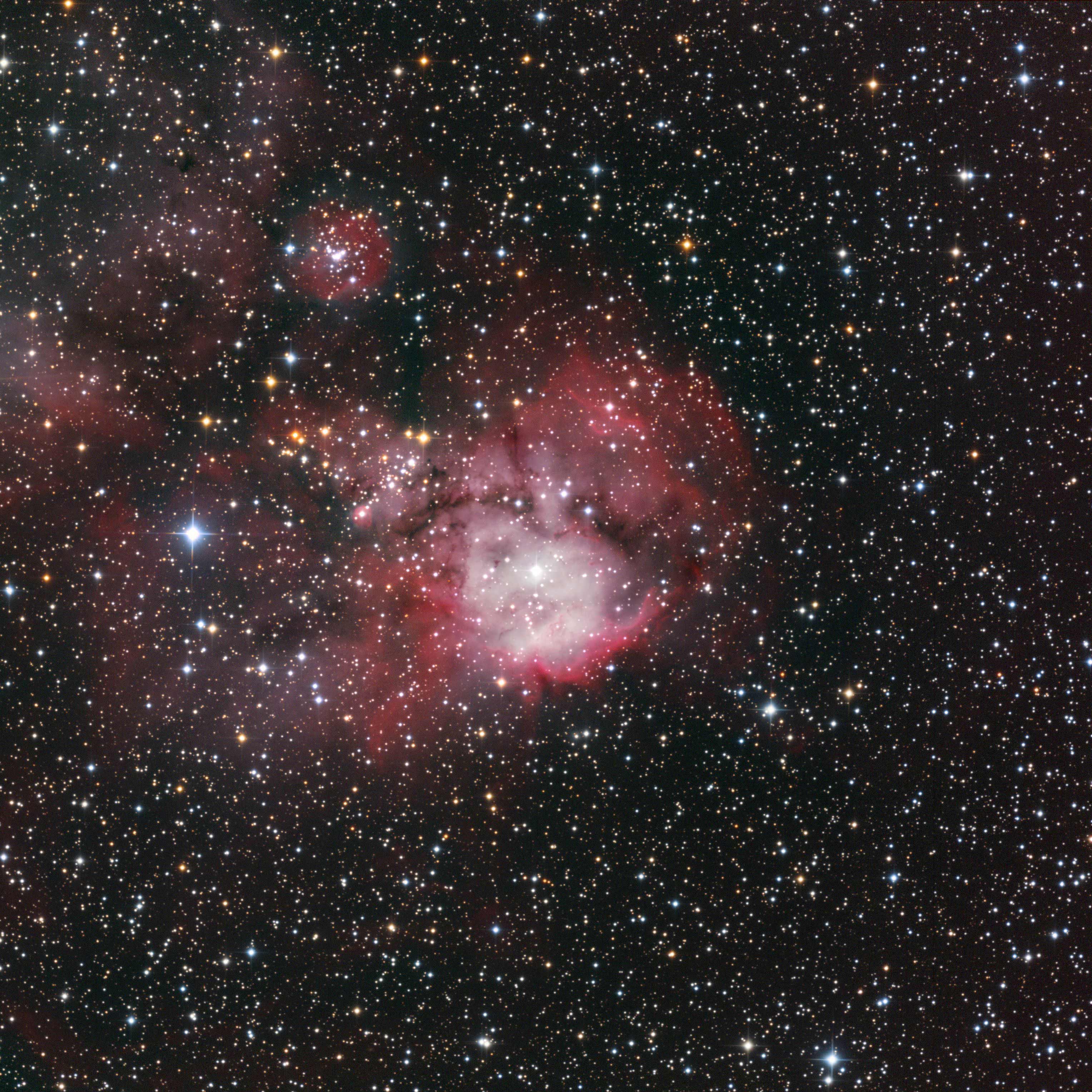 |
 |
 |
| IC 4812 -
The Coal Sack Down in our southern constellation of Crux lies The Coal Sack, another dark nebula. It is about 600 LYs away and is about 50 LYs across. It was first reported to Europeans in 1499 by the Spanish Explorer Vicente Yanez Pinzon, although its existence was know to peoples of the southern hemisphere since our ancient ancestors first looked up to the night sky. Scientist forecast that this entire region is eventually going to be a star-making factory as the dust particles come together through the force of gravity, eventually igniting as brand new stars. Image processed by Ron Yelton. Original data from Telescope Live Observation Bundle |
NGC
3199 This image is my second full blown attempt at processing with PixInsight. The data was provided by Mike Selby to Adam Block who in turn made it available for download on his website (AdamBlockStudios.com) in conjunction with his Cosmic Canvas tutorial series. The Cosmic Canvas series is definitely more advanced than what I was prepared for, although I'm glad I made the attempt. Processing consisted of merging the color data from one telescope with the narrow band data from a different size telescope. It took me a month of following along with Adam on his tutorial. This is a nebula that was imaged with narrow band filters (HSO), the stars removed, processed and then merged with the stars from a different image of a different scale. Sounds complicated - it was!!! Ron Yelton / Telescope Live |
Sh2-126
- The Great Lacerta Nebula This is an emission nebula located in the constellation Lacerta (The Lizard). It has the same angular size as the Andromeda Galaxy. Because it is so large and diffuse, it can only be seen with long exposure imaging. The nearby hot and bright main sequence blue star 10 Lacerae, gives off enough energy to heat the red hydrogen gas enough that it begins to glow. It is located about 1200 light-years away from us. Image processed by Ron Yelton. Original data from Telescope Live Observation Bundle |
|
Location:
Heaven's Mirror Observatory,
Australia
Date: July - August 2022 Mount: Paramount MX+ Telescope: FSQ-106ED (AUS-2) Camera: FLI PL16083 @ -25c Exposure: 10 x 10 min each for LRGB. Total: 1hr 50min |
Location:
Unkown
Date: Unkown Mount: Unkown Telescope: Unkown Camera: Unkown Exposure: Unkown |
Location: IC Astronomy Observatory, Spain
Date: July 1, 2022 Mount: Paramount MX+ Telescope: Takahashi FSQ-106ED (SPA-1) Camera: QHY600m CMOS @ -25c Exposure: RGB 20x180sec, Ha 33x10min Total: 5.5 hrs |
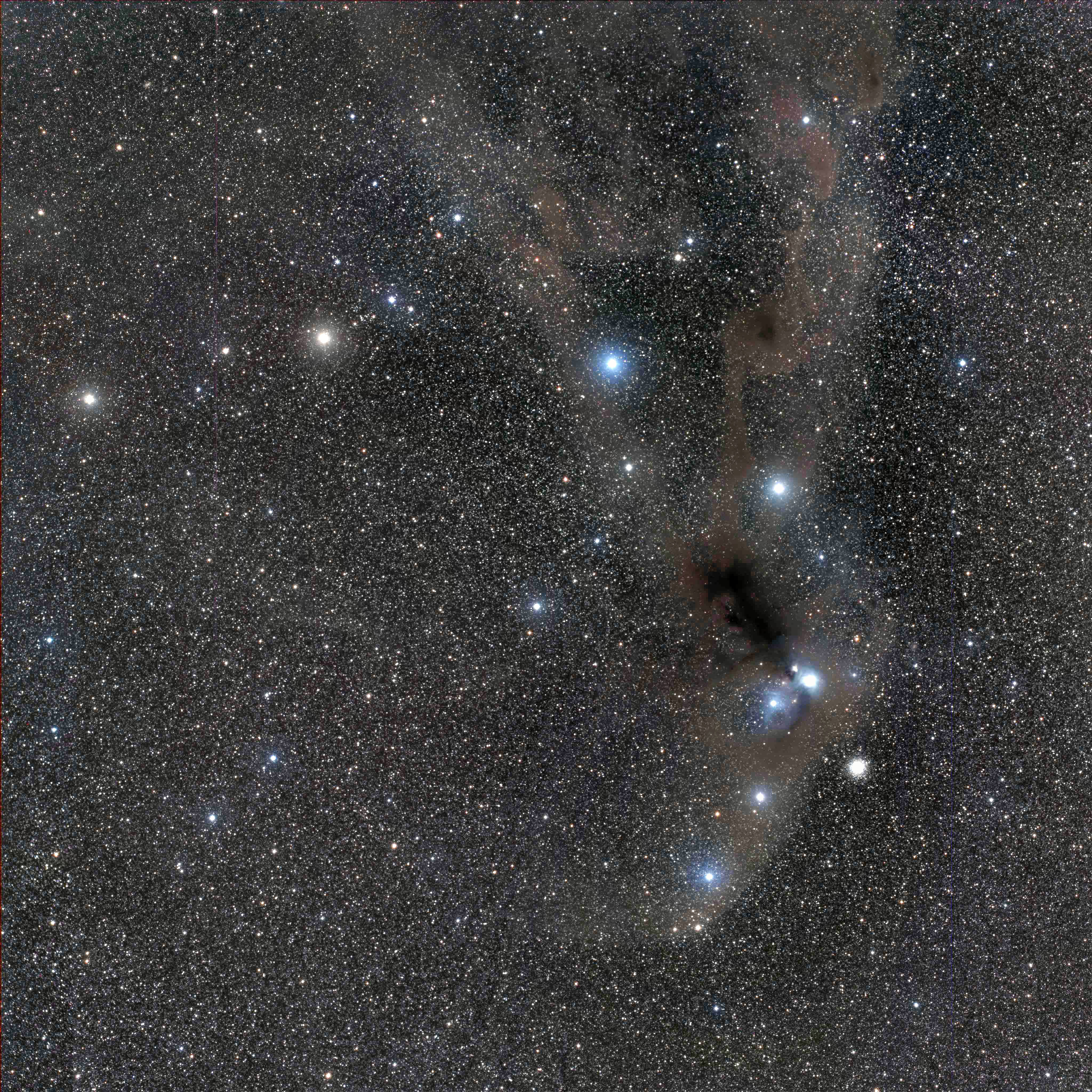 |
 |
 |
| NGC 6559 -
The Loreta Nebula This nebula is in Sagittarius and lies along the edge of a large molecular cloud that also contains Messier 8, The Lagoon Nebula. It is also an active star forming region. There are two types of nebula working here - the reddish areas are emission nebulae and the bluish areas are reflection nebulae. The dark lanes are dark nebulae - cold dust and gas that blocks the light coming from behind. It lies about 5000 light-years from Earth and is about 130 light-years across. Image processed by Ron Yelton. Original data from Telescope Live Observation Bundle |
NGC
2359 -
Thor's Helmet
Here is a series of five images of Thor's Helmet. They were processed in HSO and SHO. The Hydrogen and Sulphur channels were swapped and then some green removed. It's just a cool study in how the exact same image can turn out so completely different based on the processor's sense of artistry. Thor's Helmet is an emission nebula located in Canis Major. It lies 12,000 light years away from us and its central star is a Wolf-Rayet star which is thought to be in a pre-supernova stage of evolution. Image processed by Ron Yelton. Original data from Telescope Live Observation Bundle |
NGC
2359 -
Thor's Helmet Image processed by Ron Yelton. Original data from Telescope Live Observation Bundle |
|
Location: El
Sauce Observatory, Chile
Date: Apr-Jul2022 Mount: Mathis MI-1000 Telescope: Planewave CDK24 f/6.6 (CHI-1) Camera: QHY600m CMOS @ -25c Exposure: 24 x 10 min LRGB Total:4 hrs |
Location: El
Sauce
Observatory,
Chile
Date: Nov 2020 - Mar 2023 Mount: ASA Alt-Az Telescope: ASA RC-1000AZ (6800mm) (CHI-3) Camera: FLI PL16803 (CCD) Exposure: 180sec x 14 HSO Total: 42 min |
Location: El
Sauce
Observatory,
Chile
Date: Nov 2020 - Mar 2023 Mount: ASA Alt-Az Telescope: ASA RC-1000AZ (6800mm) (CHI-3) Camera: FLI PL16803 (CCD) Exposure: 180sec x 14 HSO Total: 42 min |
 |
 |
 |
| NGC
2359 -
Thor's Helmet Image processed by Ron Yelton. Original data from Telescope Live. |
NGC
2359 -
Thor's Helmet Image processed by Ron Yelton. Original data from Telescope Live. |
NGC
2359 -
Thor's Helmet Image processed by Ron Yelton. Original data from Telescope Live. |
|
Location: El
Sauce
Observatory,
Chile
Date: Nov 2020 - Mar 2023 Mount: ASA Alt-Az Telescope: ASA RC-1000AZ (6800mm) (CHI-3) Camera: FLI PL16803 (CCD) Exposure: 180sec x 14 HSO Total: 42 min |
Location: El
Sauce
Observatory,
Chile
Date: Nov 2020 - Mar 2023 Mount: ASA Alt-Az Telescope: ASA RC-1000AZ (6800mm) (CHI-3) Camera: FLI PL16803 (CCD) Exposure: 180sec x 14 HSO Total: 42 min |
Location: El
Sauce
Observatory,
Chile
Date: Nov 2020 - Mar 2023 Mount: ASA Alt-Az Telescope: ASA RC-1000AZ (6800mm) (CHI-3) Camera: FLI PL16803 (CCD) Exposure: 180sec x 14 HSO Total: 42 min |
 |
 |
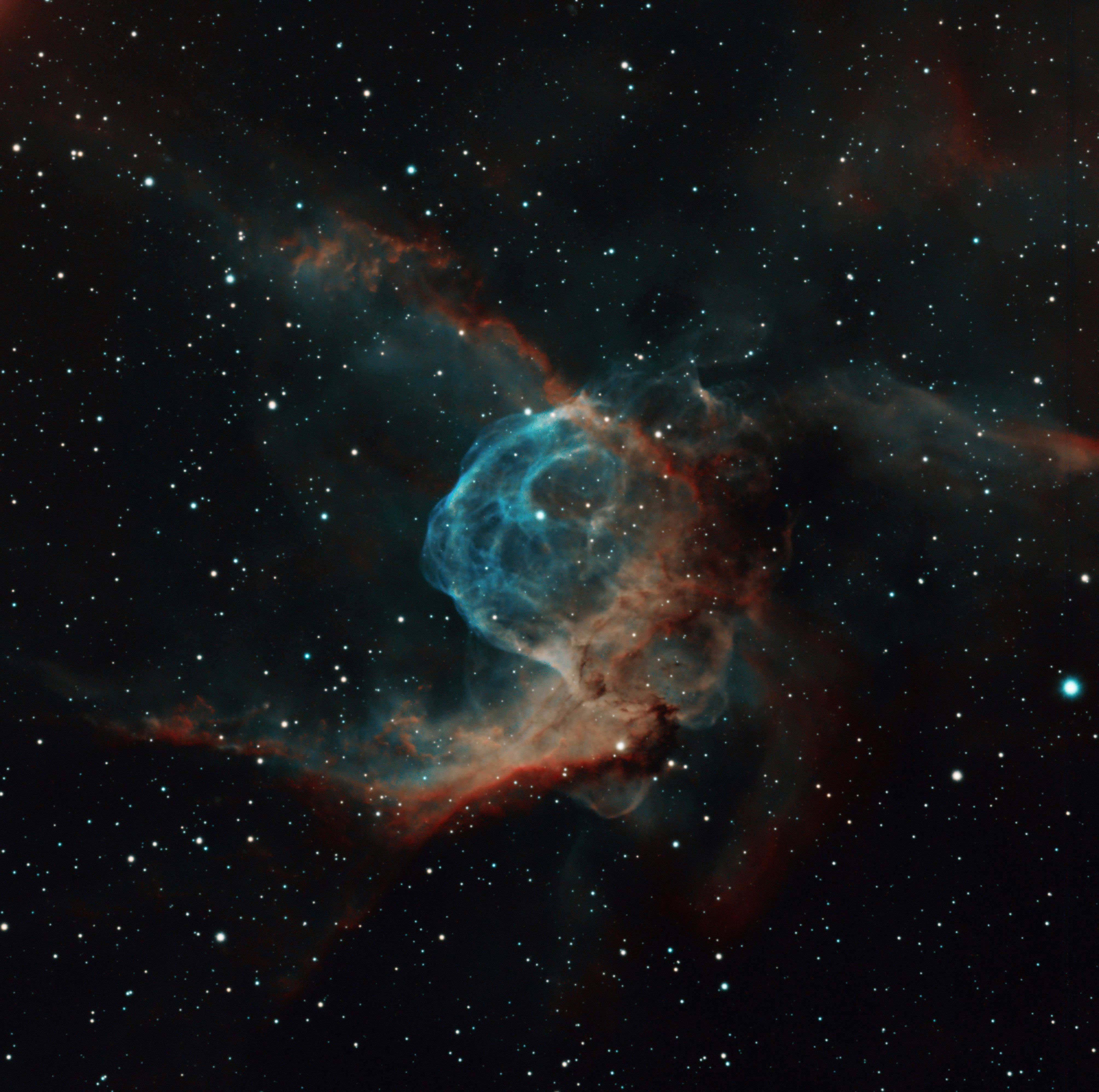 |
| Henize
70 - A
Super-Bubble
in the Large Magellanic
Cloud Description quoted from Ann's Astronomy News "Henize 70 is a bright superbubble of about 300 light-years across within the Large Magellanic Cloud (a satellite galaxy to our Milky Way galaxy), located some 160,000 light-years away in the southern constellation of Dorado. Superbubbles are large bubbles of interstellar gas, blown by winds from hot, massive stars and supernova explosions, and their interiors are filled with tenuous, hot expanding gas. At the center of Henize 70 is a small group of extremely hot and massive stars. Some of these stars are rapidly losing mass and have stellar winds blowing from their surfaces with velocities that approach 4000 kilometers per second. Because the lifetimes of massive stars are measured in only tens of millions of years, after one supernova has swept clear a bubble around itself, there isn't enough time for the interstellar medium to back-fill the cavity before other stars explode in the same region. Each subsequent supernova will rejuvenate the cavity left by the previous ones. These superbubbles provide astronomers with an excellent opportunity to explore the connection between the life-cycles of stars and the evolution of galaxies." Image processed by Ron Yelton. Original data from Telescope Live. Hubble palette. |
Messier
42
(M42) The
Great Orion
Nebula
The Orion Nebula is a diffuse nebula located about 1600 light years away and is about 24 light years across. The bright central region known as the Trapezium is an active star making area. The Trapezium consists of four hot, young stars. If you're observing from a good dark-sky site there are two additional stars that can be resolved with a good telescope which make the Trapezium an open star cluster. This nebula is just part of a larger cloud of gas and dust that encompasses most of the constellation Orion. Processed by Ron Yelton. Original data from Telescope Live. |
NGC 3372 - The
Great Carina
Nebula (SHO) This another version of the Carina Nebula. the first version is a couple of rows above this one. the first version was done back in 2021 and was processed with Photoshop. this version used a different telescope and was processed with Pixinsight. Certain areas of processing in PS always seemed to be just beyond me. With Pixinsight I've put in a ton of time with tutorials. At first look, Pixinsight looks like it's beyound comprehension, but with time and erffort it turns out to be one heck of a powerful software suite. Glad i made the leap. this version was processed in the Hubble Palette (SHO) The Carina Nebula was discovered by Nicolas-Louis de Lacaille in 1752 from the Cape of Good Hope. It's four times the size and even brighter than the Great Orion Nebula. It lies about 8,500 light-years from Earth and includes both bright and dark areas of nebulosity as well as numerous other objects. Processed by Ron Yelton. Original data from Telescope Live. |
|
Location: El
Sauce
Observatory,
Chile
Date: February - March 2023 Mount: Mathis MI-1000 Telescope: Planewave CDK24 f/6.6 (CHI-1) Camera: QHY600m CMOS @ -25c Exposure: 15 x 10min SHO Total: 2 hrs 30 min |
Location: El
Sauce
Observatory,
Chile
Date: Dec20-Feb21 Mount: Mathis MI-1000 Telescope: Planewave CDK24 f/6.6 (CHI-1) Camera: FLI ProLine PL 9000 @ -25c Exposure: 30 x 30 sec RGB Total: 15 min |
Location: El
Sauce
Observatory,
Chile
Date: February - March 2023
Mount: ASA DDM85 Telescope: ASA 500N Camera: QHY600m @-25 (CMOS) (CHI-2/4) Exposure: 43 x 5 min SHO Total: 3.6 hrs |
 |
 |
 |
| Image
Slideshow with
Music - May
2023 This was a fun project to do. I selected some of my favorite images (both from my own rig as well as from Telescope Live) and added a sound track of original music. It's a large file - more than AOL will let me send. So, here are a couple of links - one to download the file and one to wtch the presentation here on the website. I hope you enjoy it! Both links should work just fine with any browser - except Firefox The Video version has a couple of glitches in the sound track and video that I could not fix. Sorry. Watch Video Images Slideshow with Original Music - May 2023 The Powerpoint version has a clean sound track and video. Once the file is downloaded, open it, select Slideshow at the top and then select Start from beginning on the left. It may start in Presenter's View, Look for a round circle. This will have the option to turn off Presenter's View. Download Powerpoint Images Slideshow with Original Music - May 2023 |
The
Great Lacerta
Nebula -
Sh2-126 This is a slightly different version of the Lacerta Nebula that the one a couple of rows above this one. The first image was shot with with a 24" inch telescope and this one was taken with a wider field scope. This is an emission nebula located in the constellation Lacerta (The Lizard). It has the same angular size as the Andromeda Galaxy. Because it is so large and diffuse, it can only be seen with long exposure imaging. The nearby hot and bright main sequence blue star 10 Lacerae, gives off enough energy to heat the red hydrogen gas enough that it begins to glow. It is located about 1200 light-years away from us. Processed by Ron Yelton. Original data from Telescope Live |
Cygnus
North - Cygnus, The Swan, was known and listed by the second century astronomer, Ptolmey. Cygnus is one of the easiest constellations in northern skies to spot since it is right in the middle of the Summer Triangle made up of Deneb, Vega and Altair. It is also the home of many of the nebulae that we love to observe and image. This image is of the northern section of the greater nebula which also includes supernova remnants and numerous open clusters Processed by Ron Yelton. Original data from Telescope Live |
|
Location: IC Astronomy Observatory, Spain Date: July - September 2022 Mount: Paramount MX+ Telescope: Takahashi FSQ-106EDX4 (SPA-3) Camera: QHY600m @-25c Exposure: 16 x 10 min HLRGB (CCD) Total: 2 hrs 40 min |
Location: IC Astronomy Observatory, Spain Date: November - December,, 2022 Mount: Paramount MX+ Telescope: Takahashi FSQ-106EDX4 (SPA-3) Camera: QHY600m @-25c Exposure: 12 x SHO (CCD) Total: 2 hrs |
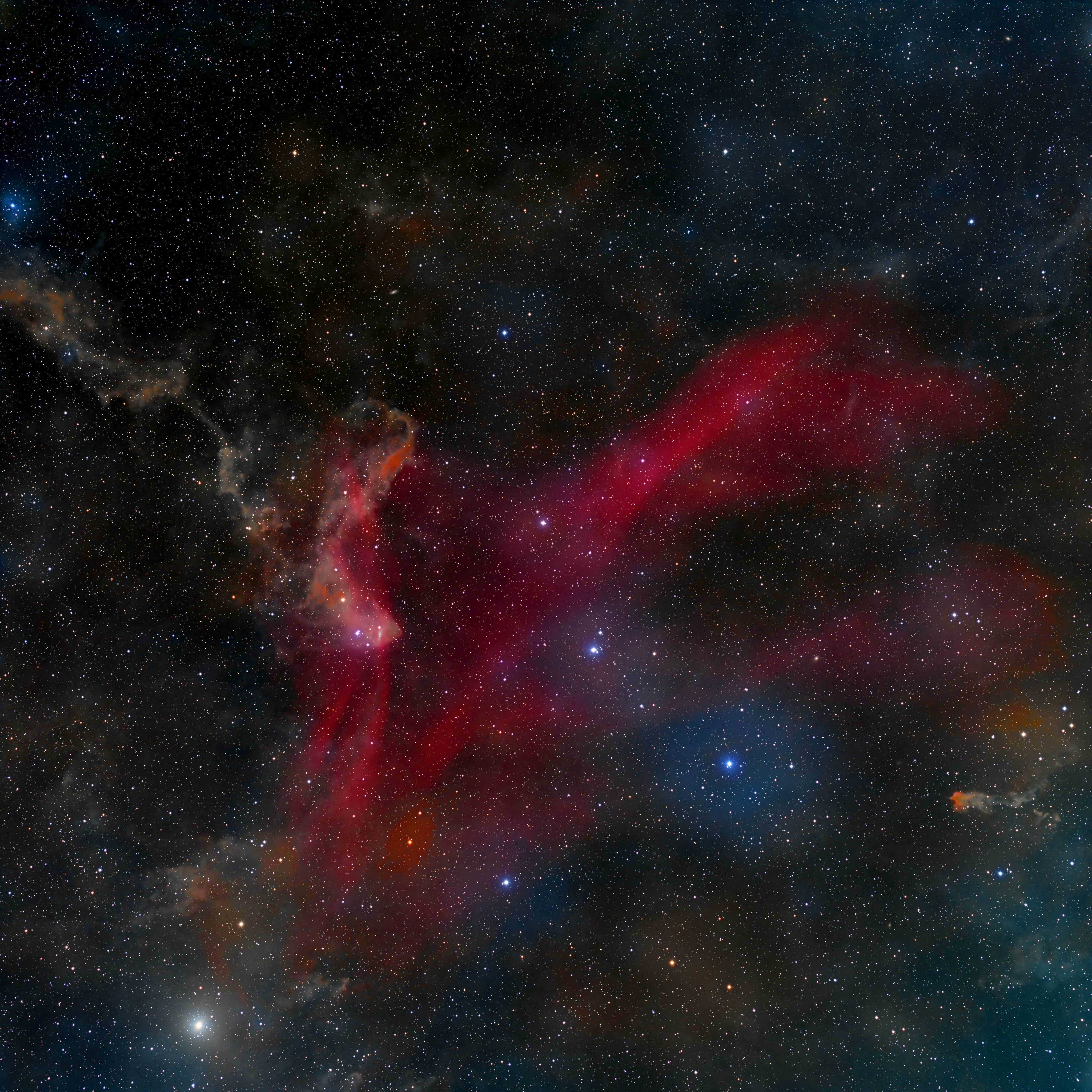 |
 |
| IC
4592 - The
Blue Horsehead
Nebula This beautiful nebula is a reflection nebula lit by Nu Scorpii in the constellation Scorpius. It is about 400 light-years away from us. Processed by Ron Yelton. Original data from Telescope Live |
IC
4592 - The
Blue Horsehead
Nebula This second image of the Blue Horsehead is the same one as the one just to the left except that all of the stars have been removed. This is a normal part of the process when processing images with Pixinsight. By separating the stars from the main object it is much easier to make changes to one or the other. If, for example you're just about finished with the image but it has a bit too much green in the sky, you can make that adjustment without affecting the rest of the image. Pretty cool Processed by Ron Yelton. Original data from Telescope Live |
NGC
3576 - The Statue
of Liberty
Nebula (With
Stars) - This wonderful nebula is situated in the constellation of Carina, in the southern hemisphere, and lies about 9000 light-years away from Earth. inside this nebula there are numerous hot, young stars. these stars give off powerful solar winds that, over time, erode the gasses into interesting shapes. This image has the stars included. the next one is a version without stars that gives it a completely different look Processed by Ron Yelton. Original data from Telescope Live |
|
Location:
Heaven's Mirror Observatory,
Australia
Date: July 10, 2021 Mount: Paramount MX+ Telescope: FSQ-106ED (AUS-2) Camera: FLI PL16083 @ -25c Exposure: 8 x 10 min each for LRGB. Total: 1hr 20min |
Location: IC Astronomy Observatory, Spain Date: July - September 2022 Mount: Paramount MX+ Telescope: Takahashi FSQ-106EDX4 (SPA-3) Camera: QHY600m @-25c Exposure: 16 x 10 min HLRGB (CCD) Total: 2 hrs 40 min |
Location:
Heaven's Mirror Observatory,
Australia
Date: January 5, 2022 - January5, 2023 Mount: Paramount MX+ Telescope: FSQ-106ED (AUS-2) Camera: FLI PL16083 @ -25c Exposure: 68 x 5 min each for SHO. Total: 4 hrs 20 min |
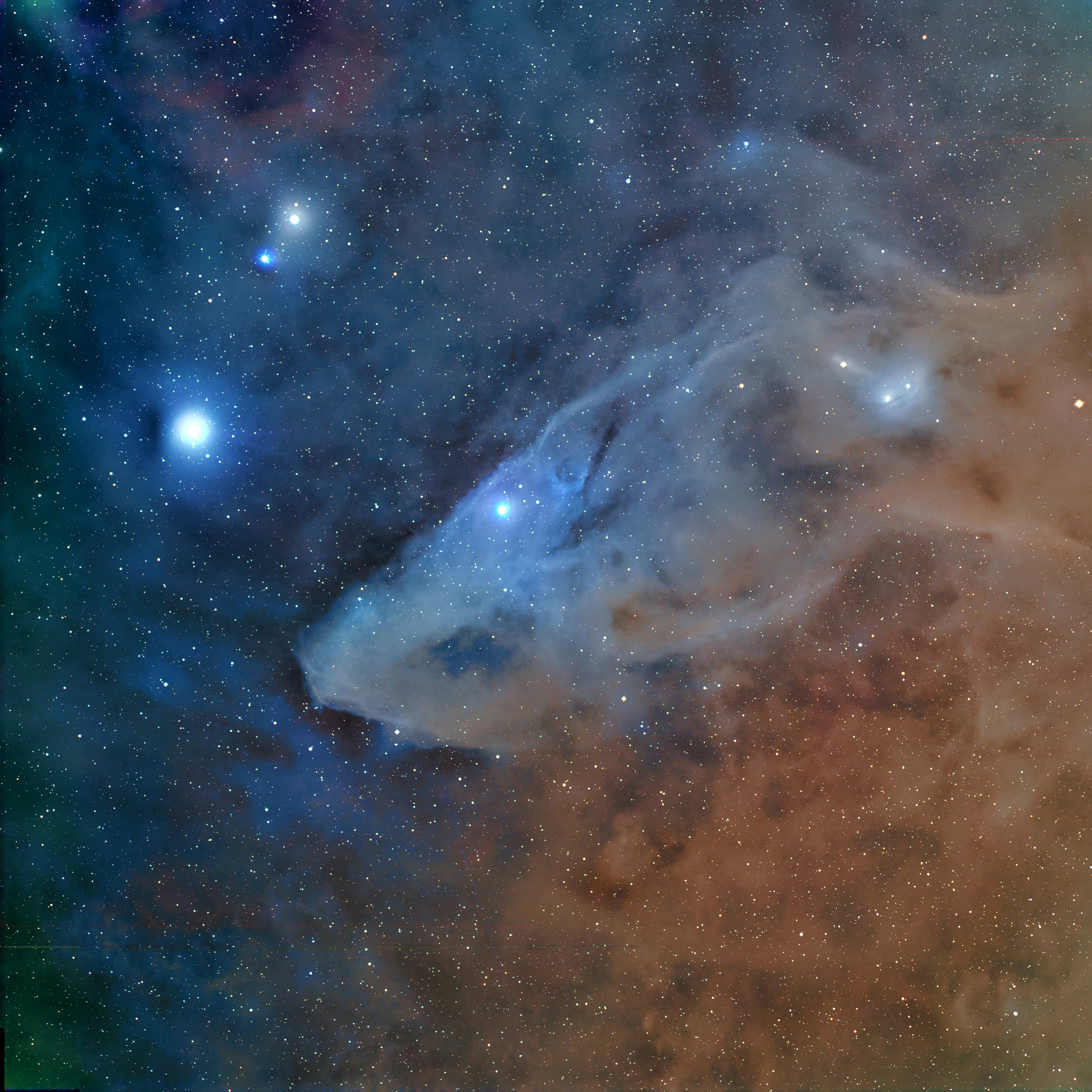 |
 |
 |
| NGC
3576 - The Statue
of Liberty
Nebula
(Without
Stars) This is the same as the preceding image, but this one has had the stars removed. The object is separated from the original image into stars-only and starless image. This is done to make it easier to process different components of the overall image separately. Sometimes the image without the stars ends up being just as interesting as the one with the stars. This image was taken Hubble Palette narrowband filters. the combination was HSO. Processed by Ron Yelton. Original data from Telescope Live |
GUM
37 - the
Southern
Tadpole Nebula
9500 light-years away in the constellation Carina, is the Southern Tadpole Nebula. This image was taken with the 24" Planewave telescope in Chile. It's a fairly large telescope, so we're only able to see the very end of the tadpole in this image. This image was taken with Hydrogen, Oxygen and Sulphur filters, also known as the Hubble Palette. thjis particular combination was HSO. Processed by Ron Yelton. Original data from Telescope Live |
GUM
37 - the
Southern
Tadpole Nebula-
Again, this image is the same as the one just to the left, except for the stars being removed. Processed by Ron Yelton. Original data from Telescope Live |
|
Location:
Heaven's Mirror Observatory,
Australia
Date: January 5, 2022 - January 5, 2023 Mount: Paramount MX+ Telescope: FSQ-106ED (AUS-2) Camera: FLI PL16083 @ -25c Exposure: 68 x 5 min each for SHO. Total: 4 hrs 20 min |
Location: IC Astronomy Observatory, Spain Date: July - September 2022 Mount: Paramount MX+ Telescope: Takahashi FSQ-106EDX4 (SPA-3) Camera: QHY600m @-25c Exposure: 16 x 10 min HLRGB (CCD) Total: 2 hrs 40 min |
Location: IC Astronomy Observatory, Spain Date: November - December,, 2022 Mount: Paramount MX+ Telescope: Takahashi FSQ-106EDX4 (SPA-3) Camera: QHY600m @-25c Exposure: 12 x SHO (CCD) Total: 2 hrs |
 |
 |
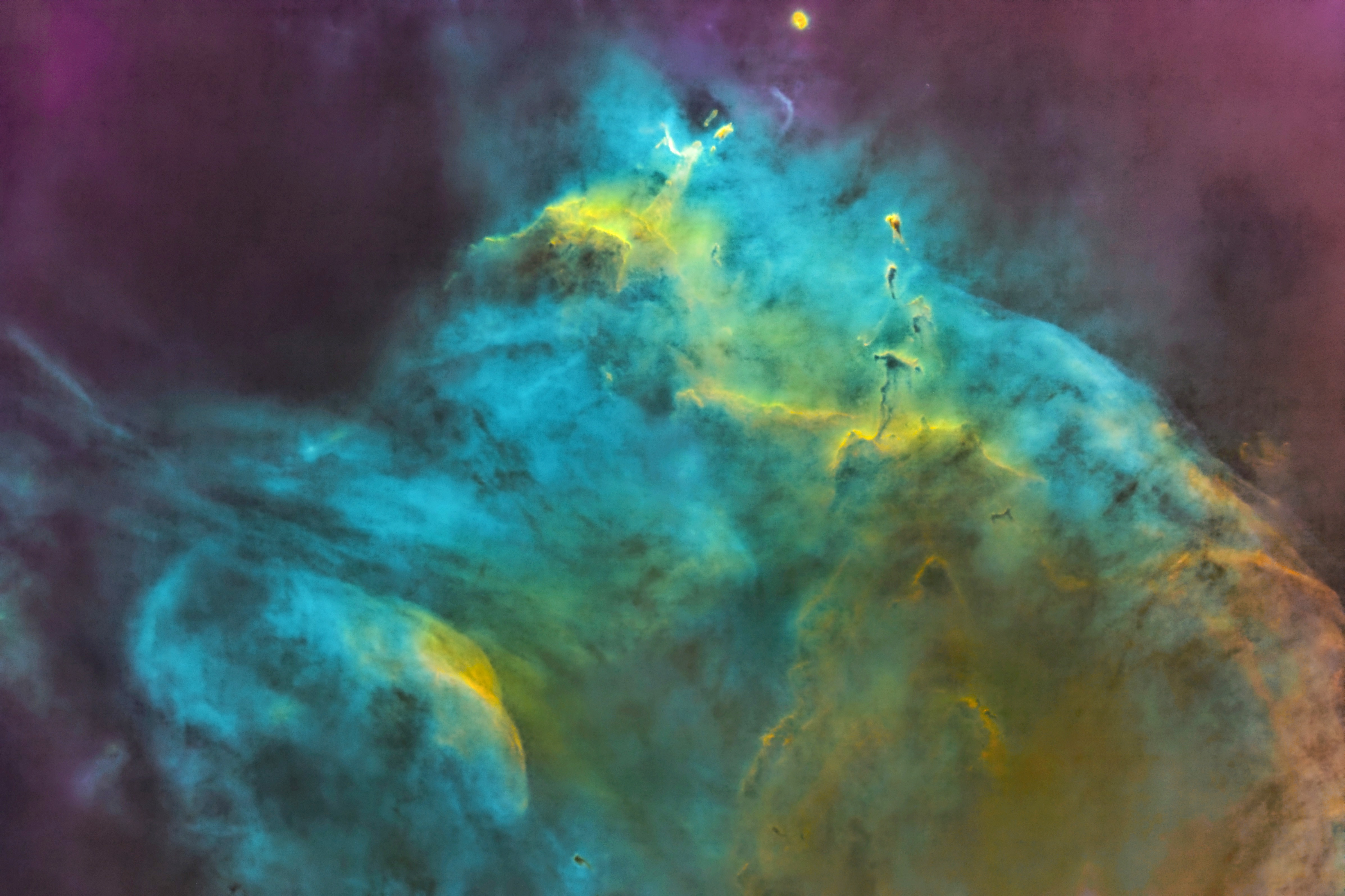 |
| RCW
2 RCW 2 is the head of the Seagull Nebula in the constellation Monoceros. The Seagull Nebula is an emission nebula, near Sirius, the brightest star in our night sky. This makes it pretty easy to find in a telescope. This image of the head of the seagull is just a small part of the rest of the nebula which 3,800 light-years away and about 100 light-years across. Taken in the Hubble Palette HSO. Processed by Ron Yelton. Original data from Telescope Live |
Messier
20 - The
Trifid Nebula Charles Messier discovered the Trifid Nebula back in 1764. He thought that id had three lobes - thus the Trifid name. This nebula is an interesting one. It has something for everyone. It contains an open star cluster, emmision and reflection nebulae as well as dark material. It lies about 4100 light-years away from us. Processed by Ron Yelton. Original data from Telescope Live |
NGC
246 - The
Cetus Bubble The Cetus Bubble is a planetary nebula located in the constellation Cetus. It lies about 1600 light-years. Processed by Ron Yelton. Original data from Telescope Live |
|
Location: El
Sauce
Observatory,
Chile
Date: April 2023 Mount: Mathis MI-1000 Telescope: Planewave CDK24 f/6.6 (CHI-1) Camera: QHY600m @-25c Exposure: 20 x 5 min HSO Total: 1 hr 40 min |
Location:
Heaven's Mirror Observatory,
Australia
Date: May 2023 Mount: Paramount MX+ Telescope: FSQ-106ED (AUS-2) Camera: QHY600m @-25c Exposure: 17 x 5min each for SHO. Total: 1 hr 25 min |
Location: El
Sauce
Observatory,
Chile
Date: June 2023 Mount: Mathis MI-1000 Telescope: Planewave CDK24 f/6.6 (CHI-1) Camera: QHY600m @-25c Exposure: 17 x 5 min HSO Total: 1 hr 35 min |
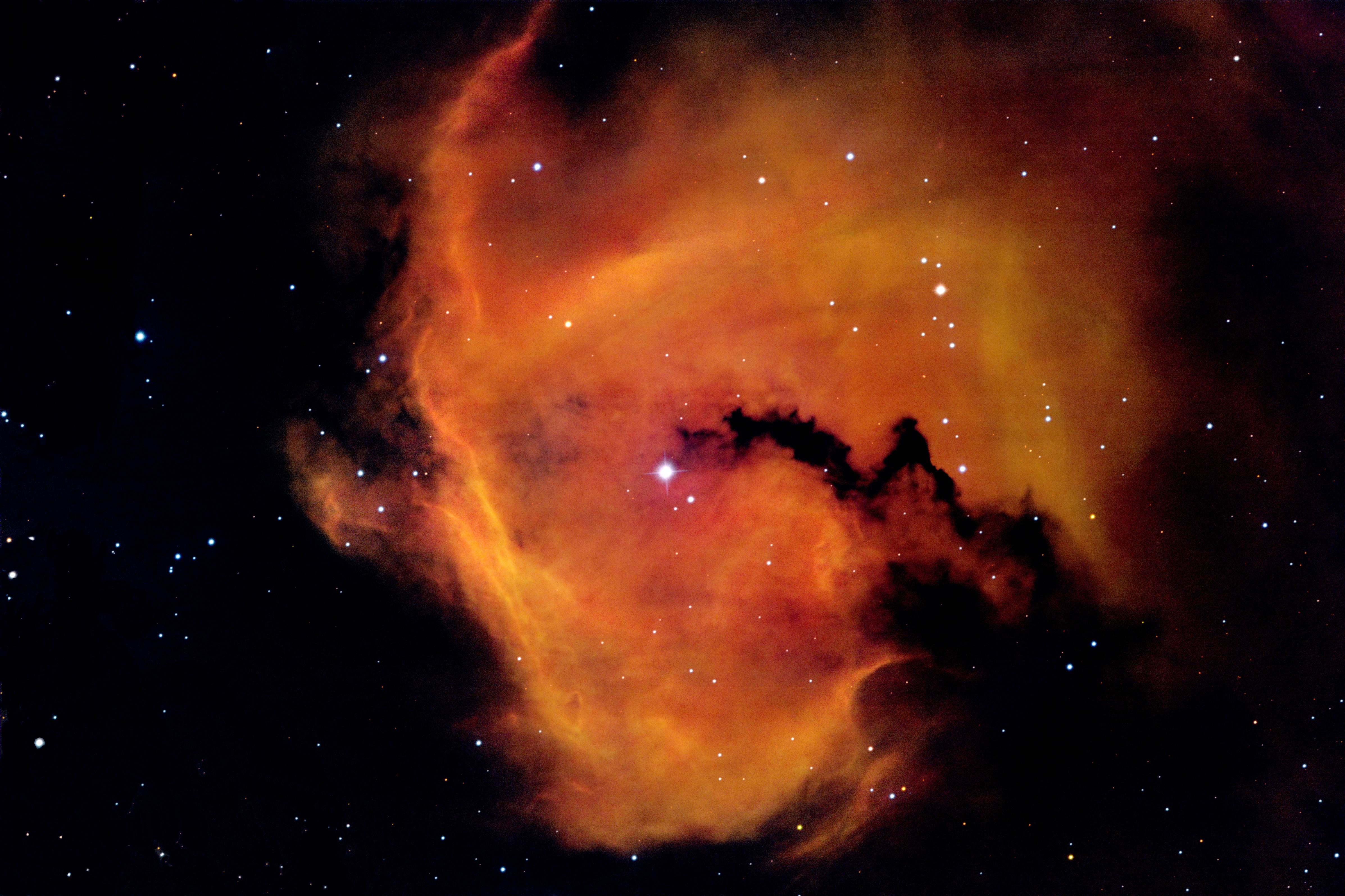 |
 |
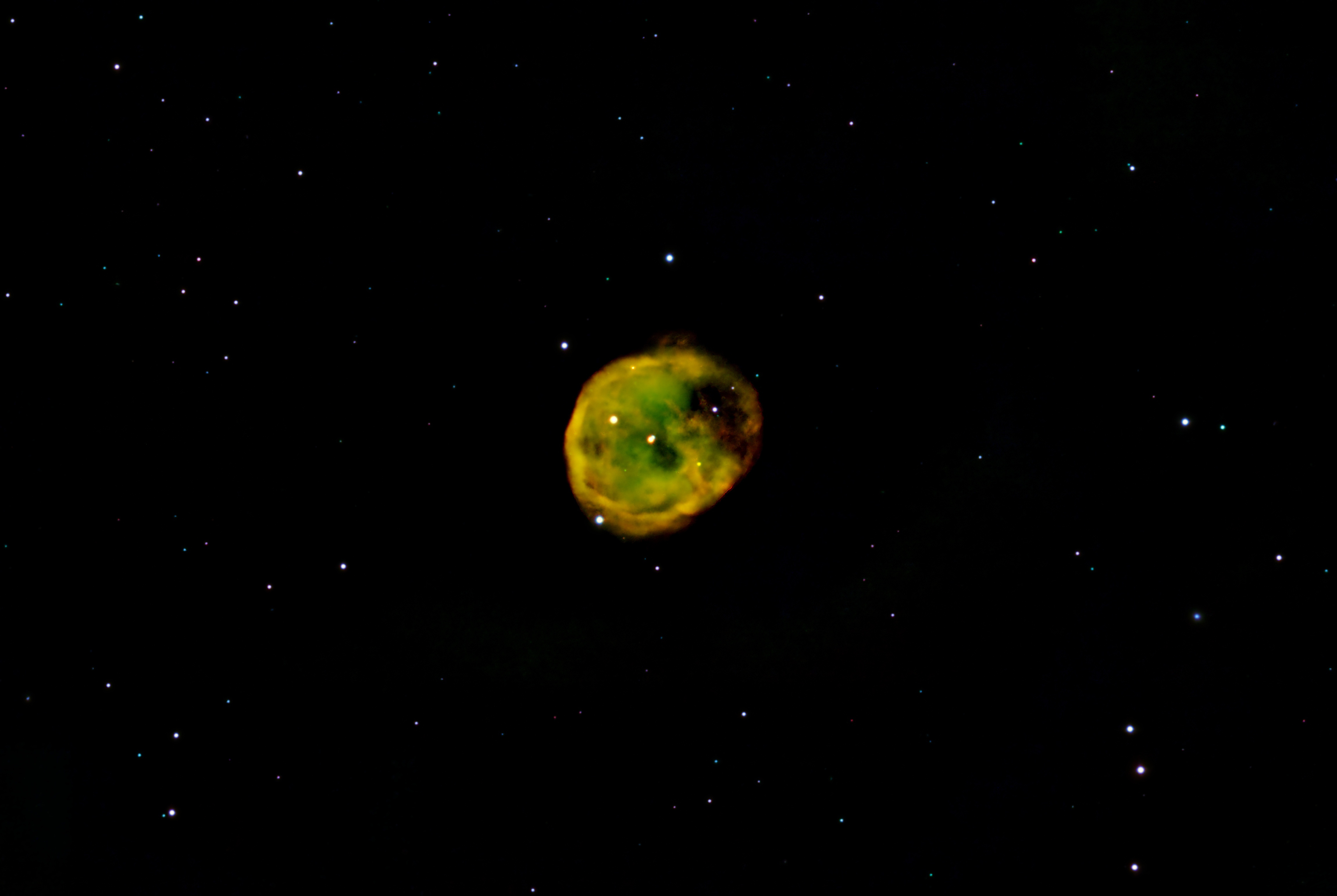 |
| NGC 7293 -
The Helix Nebula (The Eye of Sauron) When a star sheds off its outer atmosphere it comes out looking like just a disc of gas. Actually it is a sphere of gas that is expanding in all directions at the same time. These are called Planetary Nebulae. And what is left at the center is a white dwarf star. This one is about 650 light-years away in Aquarius. Processed by Ron Yelton. Original data from Telescope Live |
NGC 7293 -
The Helix Nebula (The Eye of Sauron) Here is a different version of the Helix Nebula. Using the same data set as the image to the left, I was able to bring out a bit more detail as well as more pleasing colors. Remember that when processing in The Hubble Palette, you can assign the colors to each Red, Blue and Green channel to make a completely unique image. Processed by Ron Yelton. Original data from Telescope Live |
NGC 6188
(The Rim Nebula) and NGC 6165 Also known as the Dragons of Ara, the Rim Nebula is just a small part of a much larger molecular cloud. This part of the planetary nebula contains an emission nebula that includes some dark nebula as well. It lies about 4000 light-years away from us and is about 300 light-years in diameter. The small blue nebula in the upper right has two sections - an outer bubble and an inner bubble - probably from and earlier mass ejection from its central star, a kind that lives very hot and very short. Since the larger nebula is often referred to at the Fighting Dragons of Ara, this smaller nebula is called The Dragons Egg. Processed by Ron Yelton. Original data from Telescope Live |
|
Location: El
Sauce
Observatory,
Chile
Date: April 2023 Mount: Mathis MI-1000 Telescope: Planewave CDK24 f/6.6 (CHI-1) Camera: QHY600m @-25c CMOS Exposure: 20 x 5 min HSO Total: 1 hr 40 min |
Location: El
Sauce
Observatory,
Chile
Date: April 2023 Mount: Mathis MI-1000 Telescope: Planewave CDK24 f/6.6 (CHI-1) Camera: QHY600m @-25c CMOS Exposure: 20 x 5 min HSO Total: 1 hr 40 min |
Location:
Heaven's Mirror Observatory,
Australia
Date: May 2023 Mount: Paramount MX+ Telescope: FSQ-106ED (AUS-2) Camera: QHY600m @-30c CMOS Exposure: 20 x 5min each for HSO. Total: 1 hr 40 min |
 |
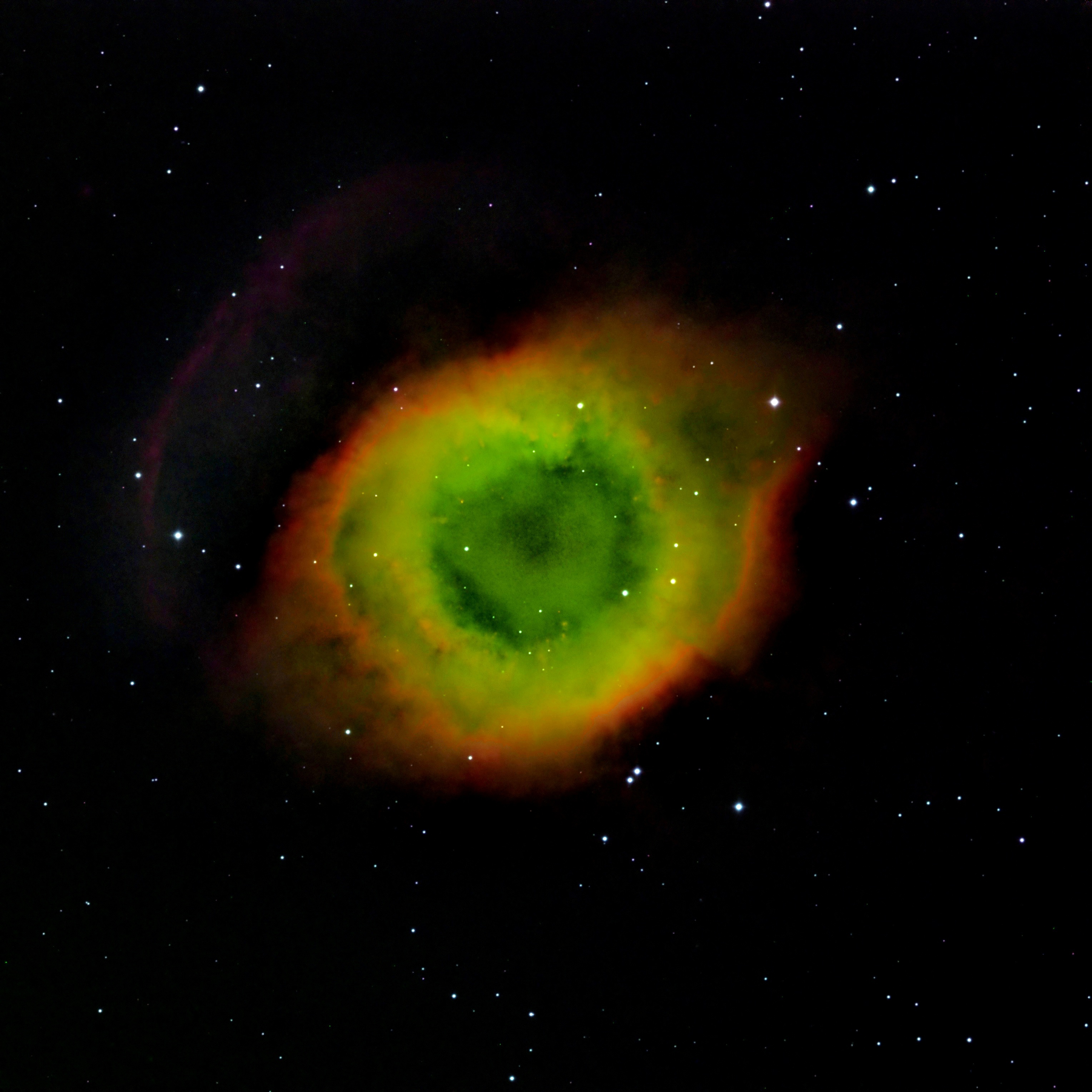 |
 |
| Tulip
Nebula to the Crescent Nebula This widefield image in the constellation Cynus, the Swan, features three objects all at once inside a vastly larger vloud of gas and dust. At the top is the Crescent Nebula. About midway down on the the left is the Cygnus Bubble. Lastly, in the lower right corner is the Tulip Nebula. This image was done in the Hubble Palette - SHO. Blue and cyan is Oxygen, while green and yellow is hydrogen gas. Processed by Ron Yelton. Original data from Telescope Live |
RCW 58 This planetary nebula lies in the constellation Carina. The central star is called a Wolf-Reyet star. These types of stars are huge, very hot and very luminous. This particular star is about 100 times the size of our Earth, a million times more luminous and 30 time the temperature. As stars use up their primary fuel - Hydrogen, they expand while ejecting their outer outer layers by way of stellar winds which gives us the red, oval nebula. these stellar winds are traveling at about 100 km / second. Processed by Ron Yelton. Original data from Telescope Live |
Messier
20 Widefield The Trifid Nebula (M20) is actually the nebula at lower-center. the larger one above it is the Lagoon Nebula (M8). both are in the constellation Sagittarius. it was discovered by Charles Messier way back in 1764. Trifid means "tree-lobed which is how it appeared in small telescopes when it was discovered. It's kind of an unusual nebula in that it is a combination of open cluster, emission nebula (red-pink), a reflection nebula (blue-cyan) and dark nebula (dark lines running trough the nebula. It's a perenial favorite viewing object at star parties in the summer. Processed by Ron Yelton. Original data from Telescope Live |

|

|
|
Location:
IC Astronomy Observatory, Spain
Date: July 2023 Mount: Paramount MX+ Telescope: Takahashi FSQ-106ED (SPA-1) Camera: QHY600m CMOS @ -25c Exposure: SHO 300sec x 19 Total: 9 hrs: |
Location: El
Sauce
Observatory,
Chile
Date: April 29, 2023 Mount: Mathis MI-1000 Telescope: Planewave CDK24 f/6.6 (CHI-1) Camera: QHY600m @-25c Exposure: HOLRGB 11 x 300 sec Total: 5.5 hrs |
Location: El
Sauce
Observatory,
Chile
Date: April 2023 Mount: Mathis MI-1000 Telescope: Planewave CDK24 f/6.6 (CHI-1) Camera: QHY600m @-25c Exposure: 20 x 5 min HSO Total: 1 hr 40 min |
| The Veil
Nebula The Veil Nebula is just a small part of the much large Cynus Loop. It consists of may sub-objects with their own names and designation numbers. It was formed when a star about 100 times the size of Earth went supernova between 10,000 and 20,000 years ago. This rendering was done in SHO, in which the red-brown regions represent hydrogen gas and the bluish regions represent oxygen gas. Processed by Ron Yelton. Original data from Telescope Live |
NGC 6164
-
the Dragon's
Egg The Dragon's Egg is an emission nebula in the constellation Norma (the Carpenter's Square). The central star that formed the nebula and the surrounding blue halo is very, very hot and weighs in at 40 x the mass of the Sun. In about 4 million years it will probably end its life as a supernova. This nebula spans about 4 light-years and lies about 4200 light-years from Earth. The Dragon's Egg is just a very small spot in a great complex of gas. It can be seen in The fighting Dragon's of Ara image on row 8, as well as in the Rim Nebula image on row 19. Processed by Ron Yelton. Original data from Telescope Live |
NGC 7293 -
The Helix Nebula (The Eye of Sauron) When a star sheds off its outer atmosphere it comes out looking like just a disc of gas. Actually it is a sphere of gas that is expanding in all directions at the same time. These are called Planetary Nebulae. And what is left at the center is a white dwarf star. This one is about 650 light-years away in Aquarius. Processed by Ron Yelton. Original data from Telescope Live |
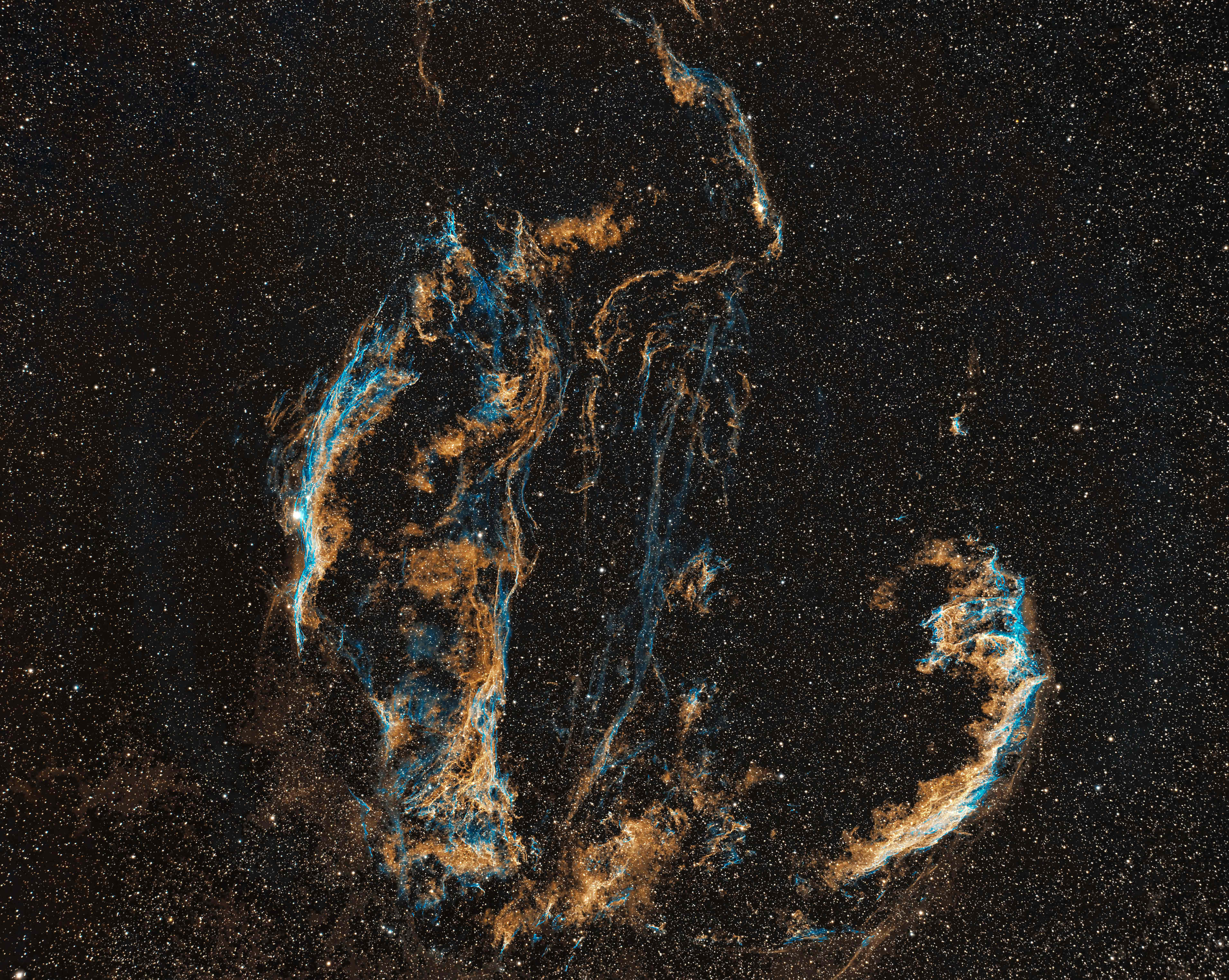 |
 |
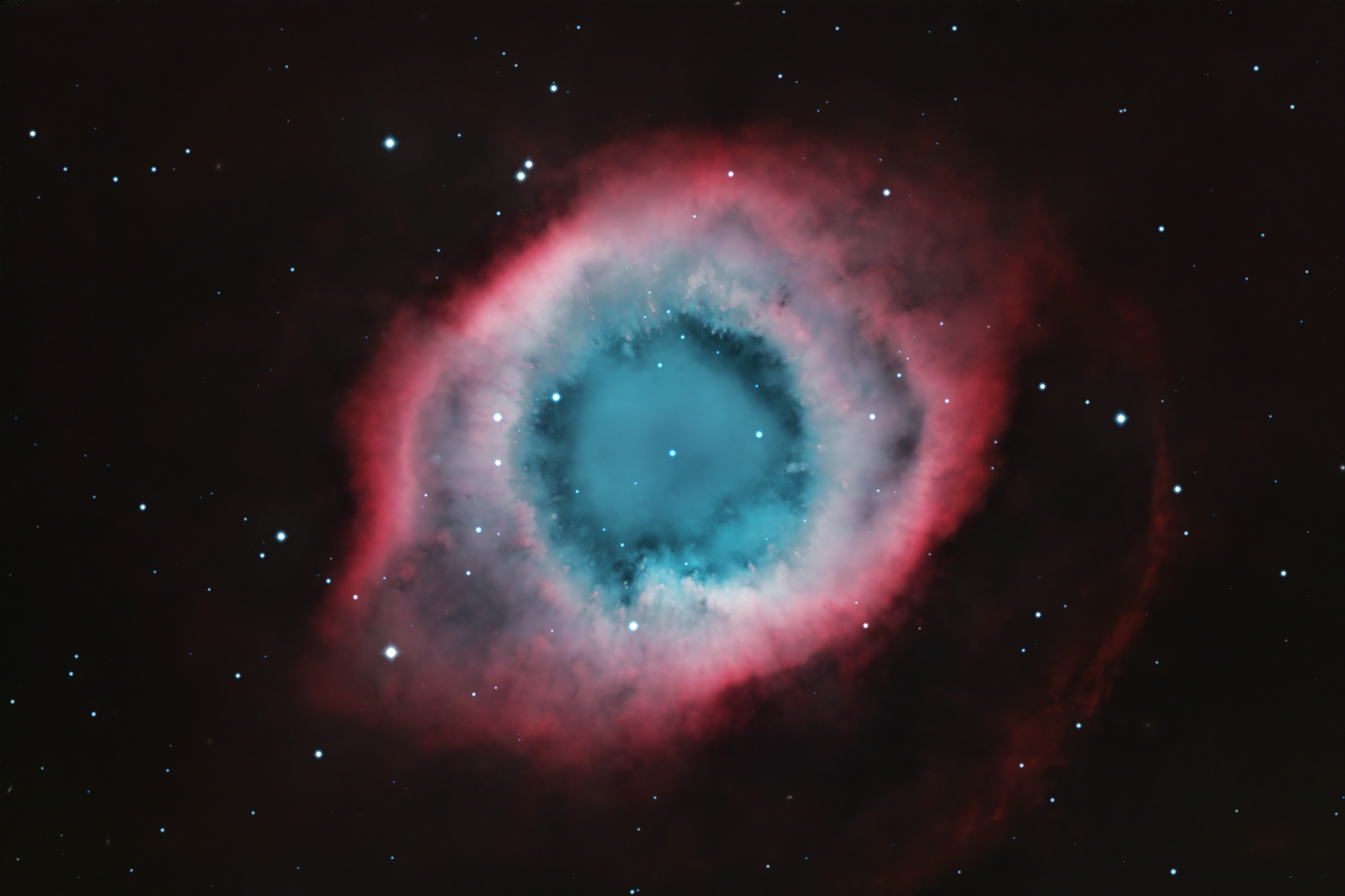 |
|
Location:
IC Astronomy Observatory, Spain
Date: July 2023 Mount: Paramount MX+ Telescope: Takahashi FSQ-106ED (SPA-1) Camera: QHY600m CMOS @ -25c Exposure: SHO 300sec x 19 Total: 9 hrs: |
Location: El
Sauce
Observatory,
Chile
Date: July 2023 Mount: Mathis MI-1000 Telescope: Planewave CDK24 f/6.6 (CHI-1) Camera: QHY600m @-25c Exposure: HSO 17 x 300 sec Total: 4.25 hrs |
Location: El
Sauce
Observatory,
Chile
Date: July 2023 Mount: Mathis MI-1000 Telescope: Planewave CDK24 f/6.6 (CHI-1) Camera: QHY600m @-25c CMOS Exposure: 24 x 5 min HSO Total: 2 hrs |
Except as noted all images Copyright © by Ron Yelton and may not be used without permission.
